From the ashes of that war emerged two strongmen - Sulla and Marius - who each fought to shape the future of the Republic. After defeating Marius, Sulla revived the office of Dictator and enacted a series of constitutional reforms returning power to the Senate at the cost of the Tribunes.
He then dismissed his Dictatorship, returned power to the Consuls, and was elected consul on regular terms in 80 BC, after which he retired. He died the following year.
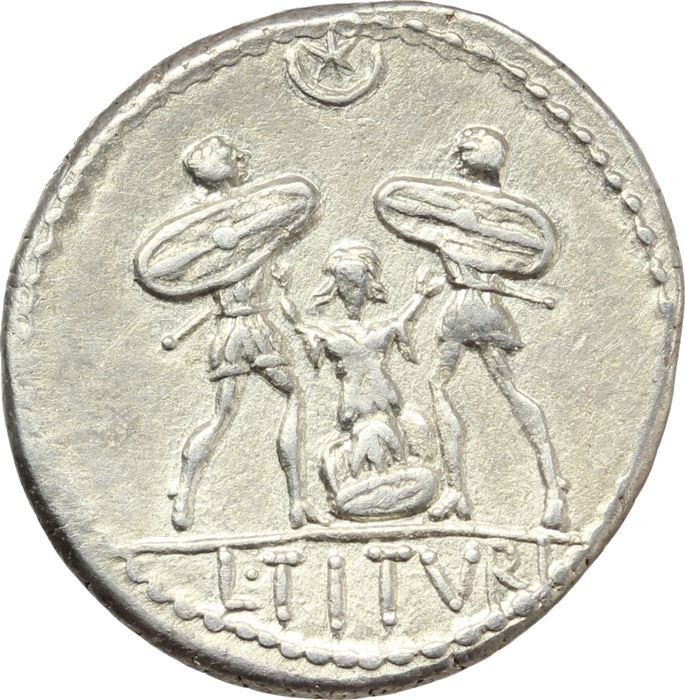

Reverse: Togate figure standing left, raising hand, between aquila and fasces. A – POST•A•F – •S•N – ALBIN across fields and in exergue.
Die Orientation: 10 H
Weight: 4.13 g
Provenance: CNG 106 (13 September 2017), lot 651. Ex Deyo Collection (Classical Numismatic Group 90, 23 May 2012), lot 1334. Stack’s (9 December 1992), lot 3177.
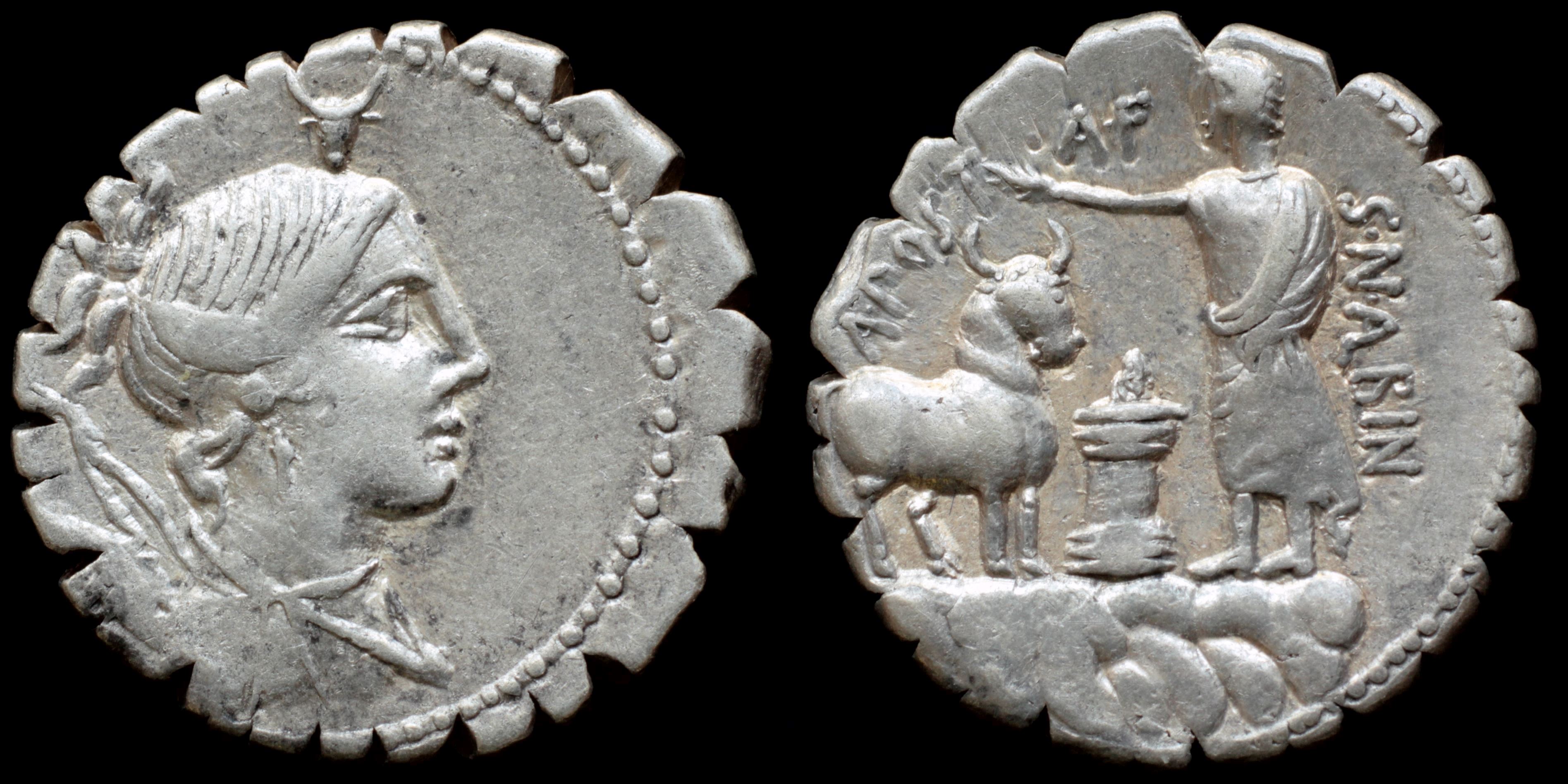
Reverse: togate figure standing left before flaming altar, holding sprinkler over sacrificial bull, all on stone platform, A·POST ·A·F S·N·(AL)BIN
Die Orientation: -
Weight: 3.7 g
According story described by Livy: in Sabina a cattle of admirable size and beauty was born. Animal was sacrificed and his skull (bucranium) was placed in temple of Diana where it commemorate this wonder. The event was considered to be a prophetic sign that town whose citizen sacrifice the animal will rule. Before battle at Regillius Lake Roman citizen (Postumius' ancestor) took the cattle and sacrificed it in the temple of Diana on Aventine.
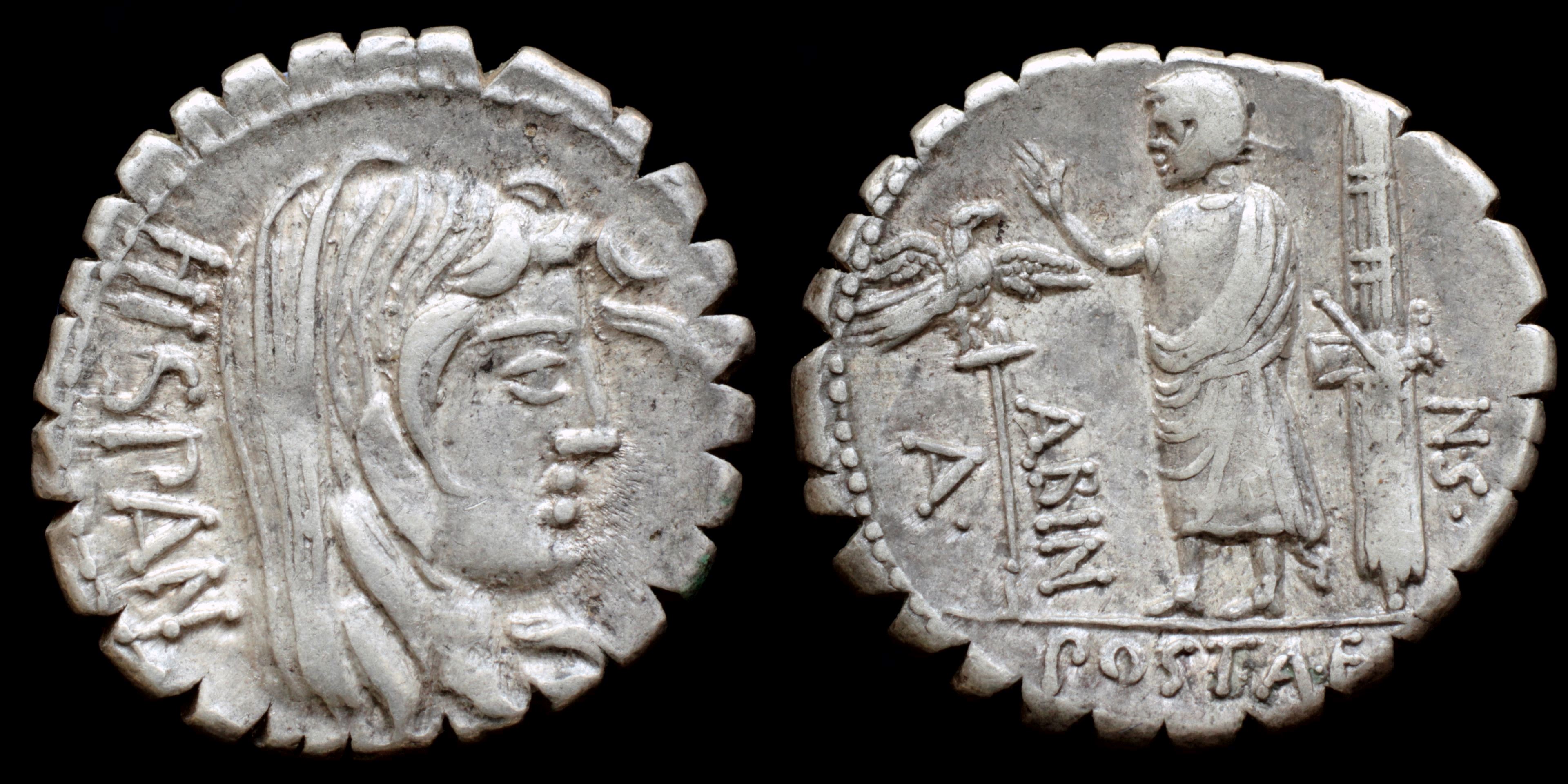
Reverse: togate figure standing left, extending hand toward legionary eagle right; fasces with axe right A· / (AL)BIN / N·S· / POST·A·F
Die Orientation: -
Weight: 3.8 g
Refers to the praetorship of L. Postumius Albinus over Spain and his successful expeditions against the Vaccaei and Lusitani, and the levying of troops for this campaign.
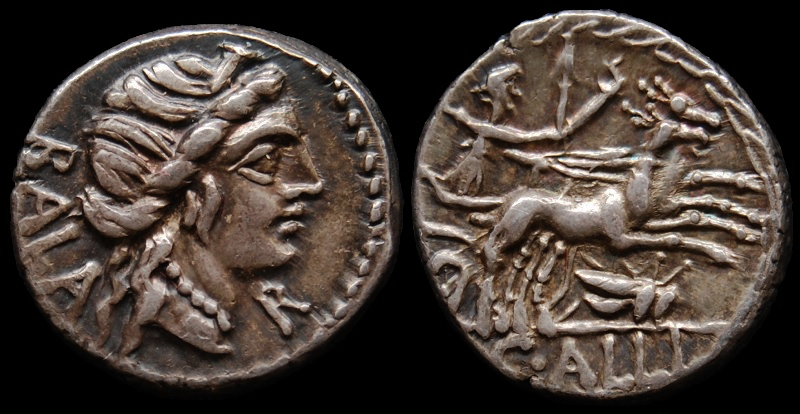
Reverse: Diana in a biga of stags to right; with quiver over shoulder and holding sceptre and reins in left hand and torch in right; grasshopper below stags, C•ALLI in exergue; all within laurel wreath.
Die Orientation: -
Weight: 3.88 g
"In Roman mythology, Diana was the goddess of the hunt, the moon and childbirth, associated with wild animals and woodland, and having the power to talk to and control animals. Oak groves were especially sacred to her. She was equated with the Greek goddess Artemis, though she had an independent origin in Italy. In myth, Diana was born with her twin brother Apollo on the island of Delos, daughter of Jupiter and Latona. Diana was known to be the virgin goddess of childbirth and women. She was one of the three maiden goddesses, along with Minerva and Vesta, who swore never to marry."
Provenance: e-Bay sale (November 2017).
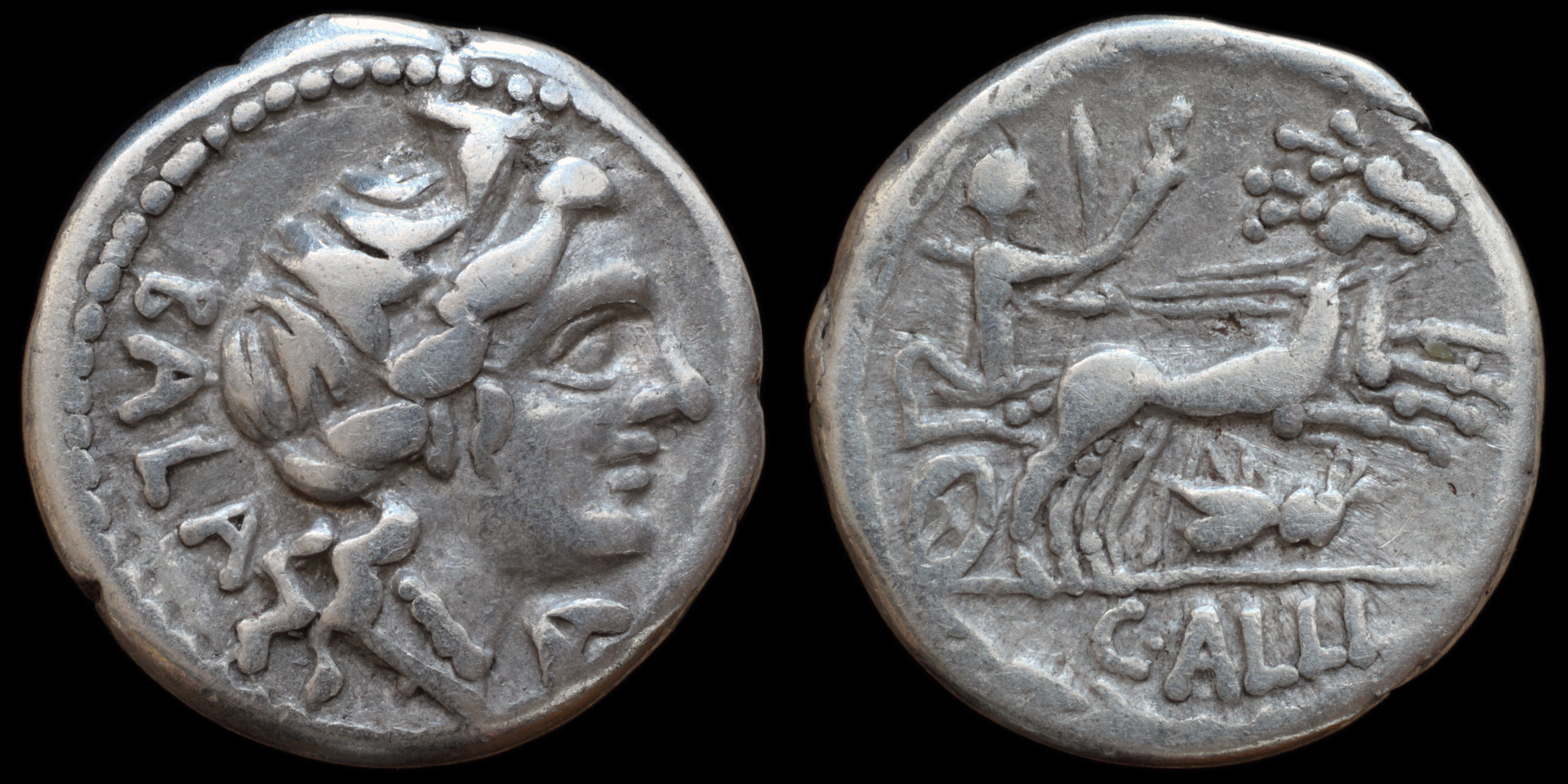
Reverse: Diana in biga of stags holding torch and scepter in right hand and reins in left hand; below grasshopper right; C•ALLI
Die Orientation: -
Weight: 3.9 g
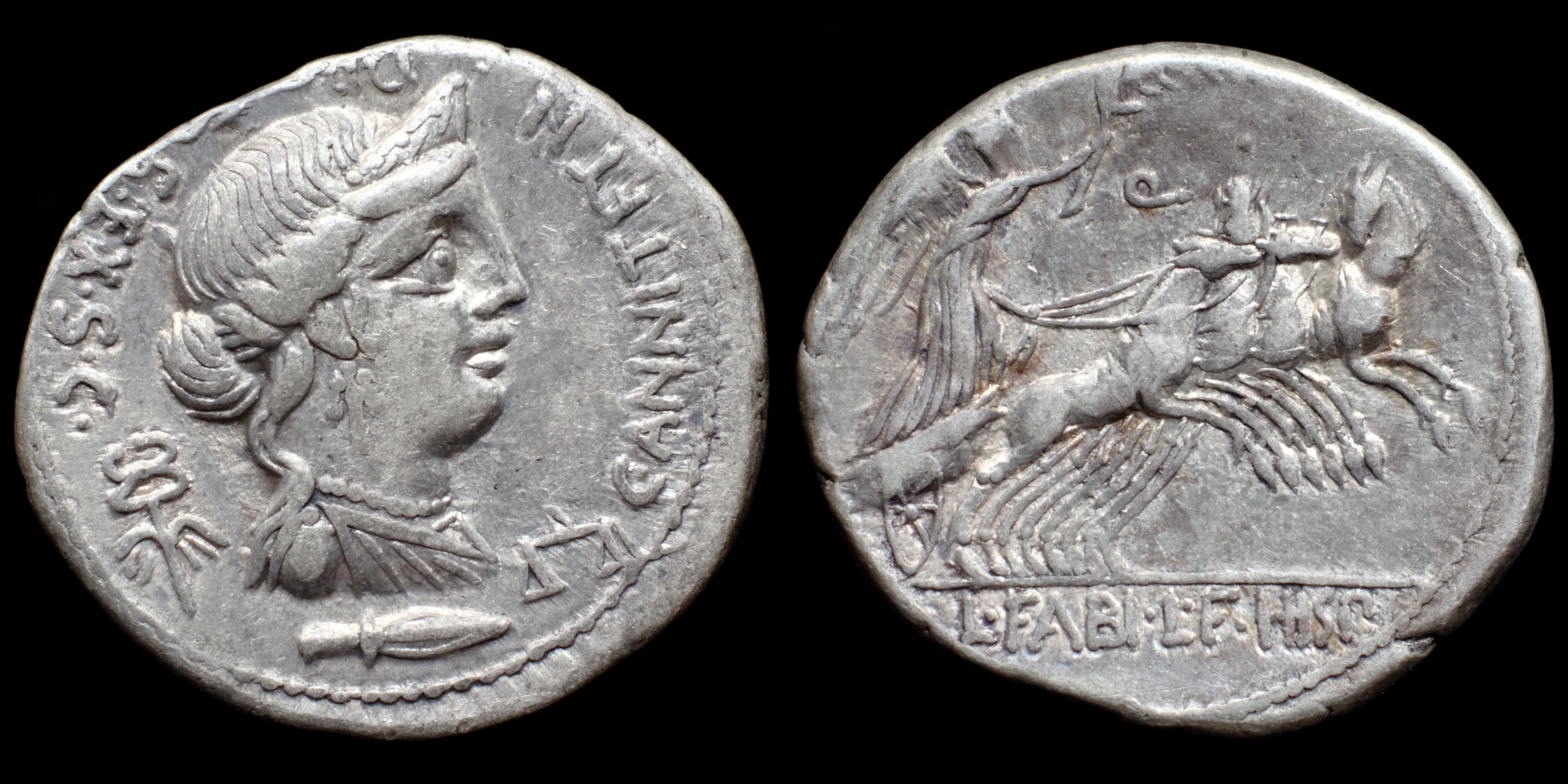
Reverse: Victory in quadriga right, holding palm branch and reins, Q / L·FABI·L·F·HISP
Die Orientation: -
Weight: 3.7 g
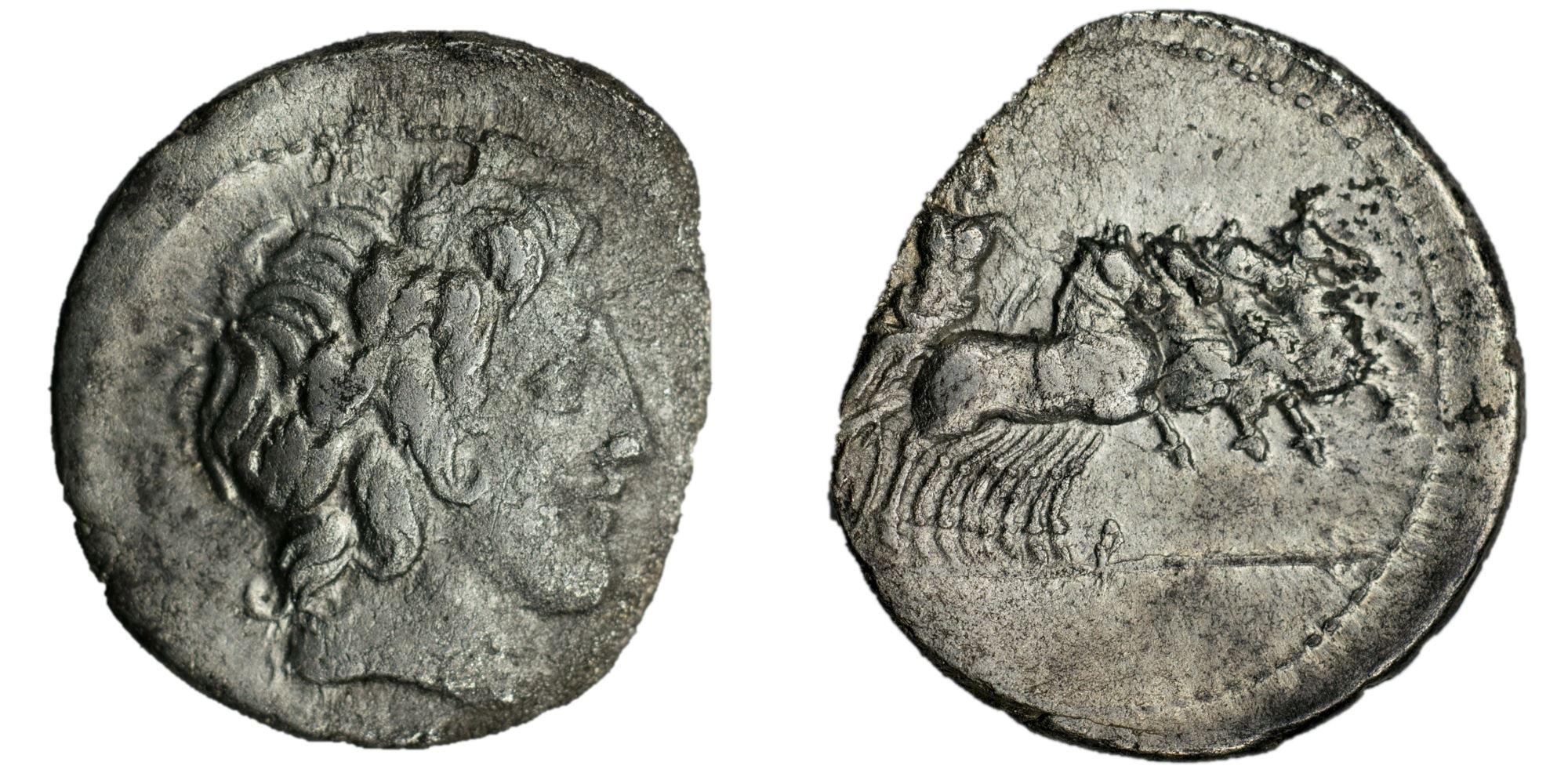
Reverse: Jupiter in Quadriga right, Holding reins and thunderbolt
Die Orientation: 3 H
Weight: 3.37 g
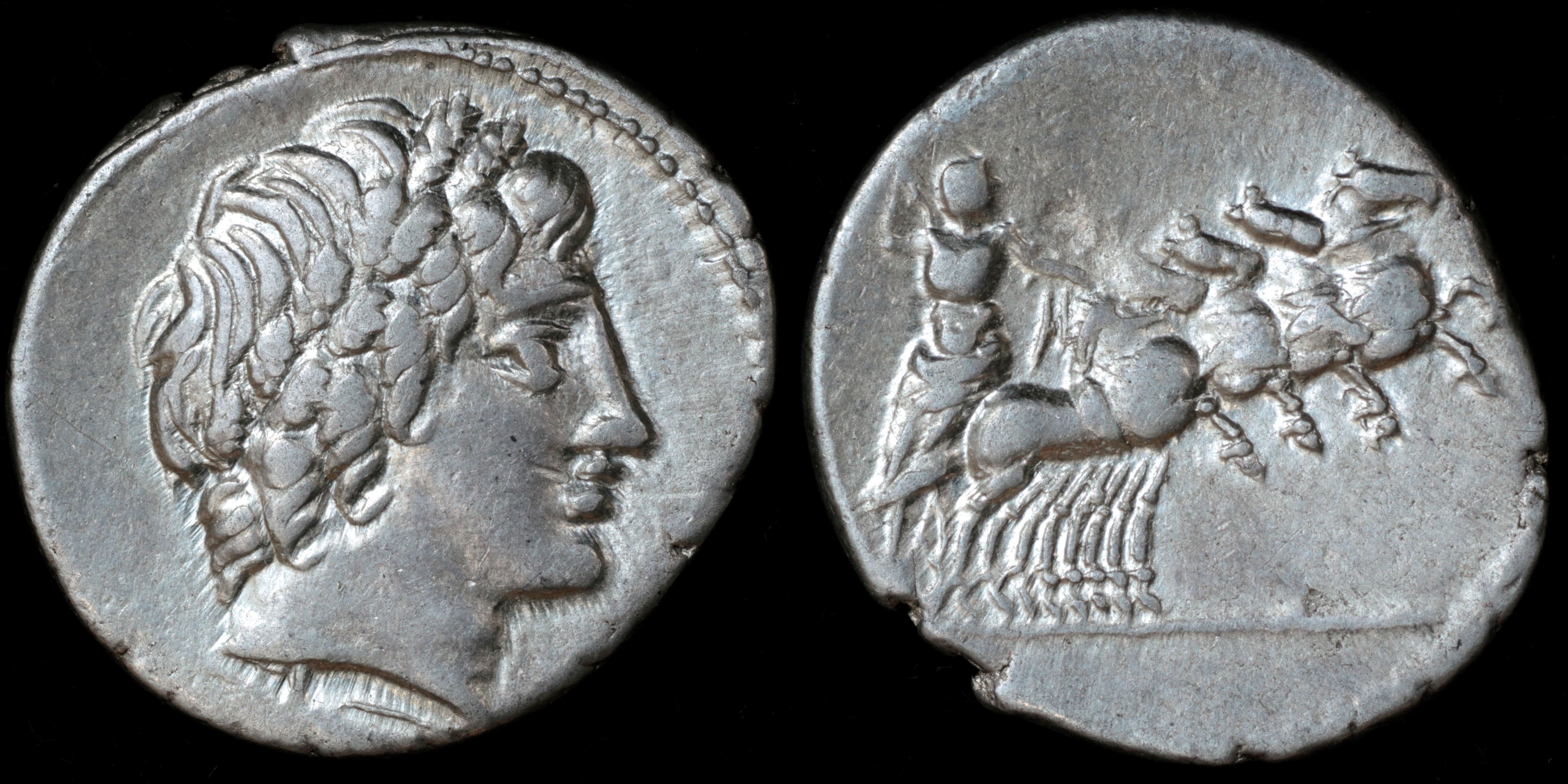
Reverse: Jupiter in quadriga right, holding thunderbolt and reins
Die Orientation: -
Weight: 3.95 g
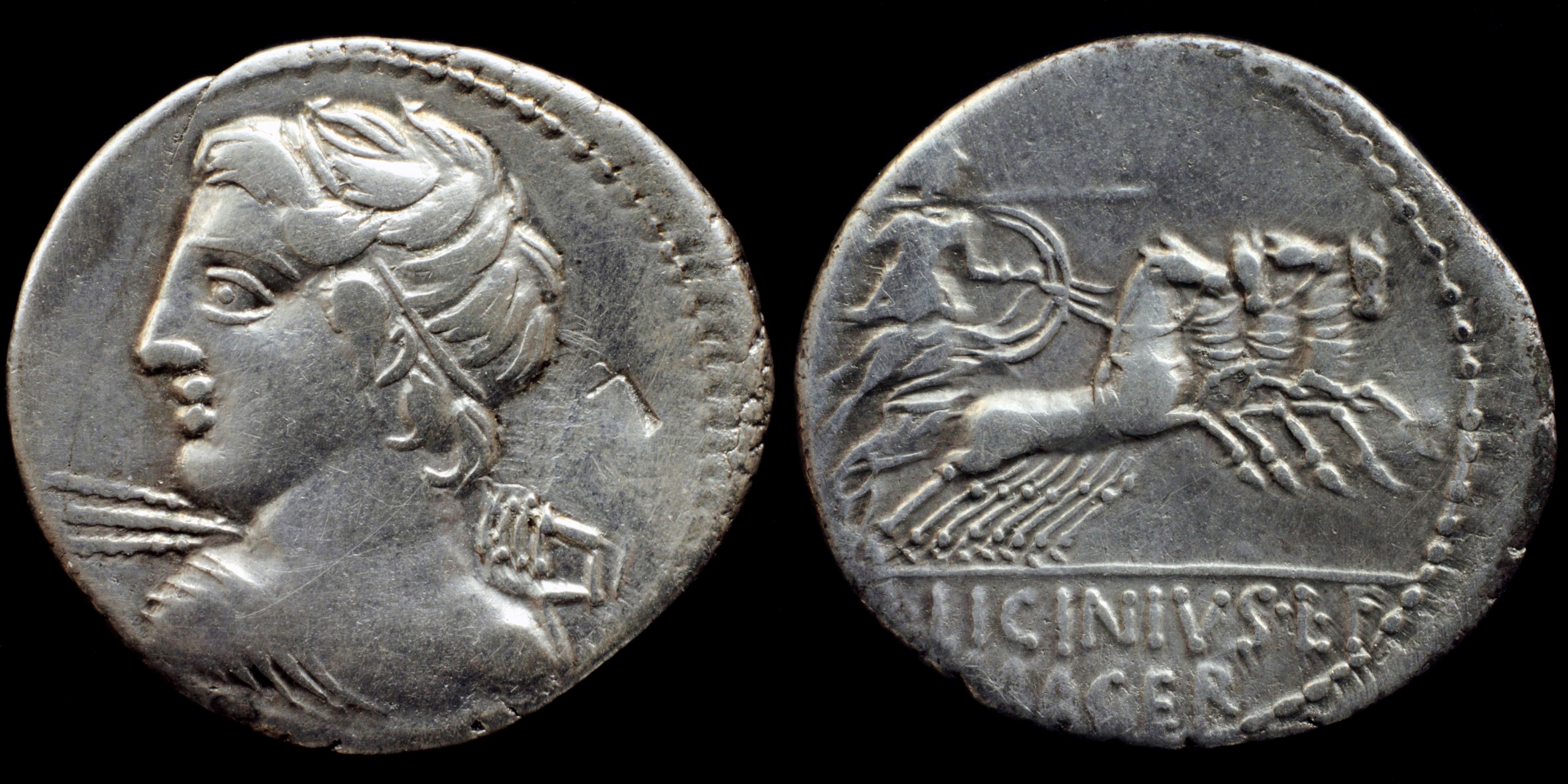
Reverse: Minerva in quadriga right holding javelin and reins, shield C·LICINIUS·L·F / MACER
Die Orientation: -
Weight: 3.66 g
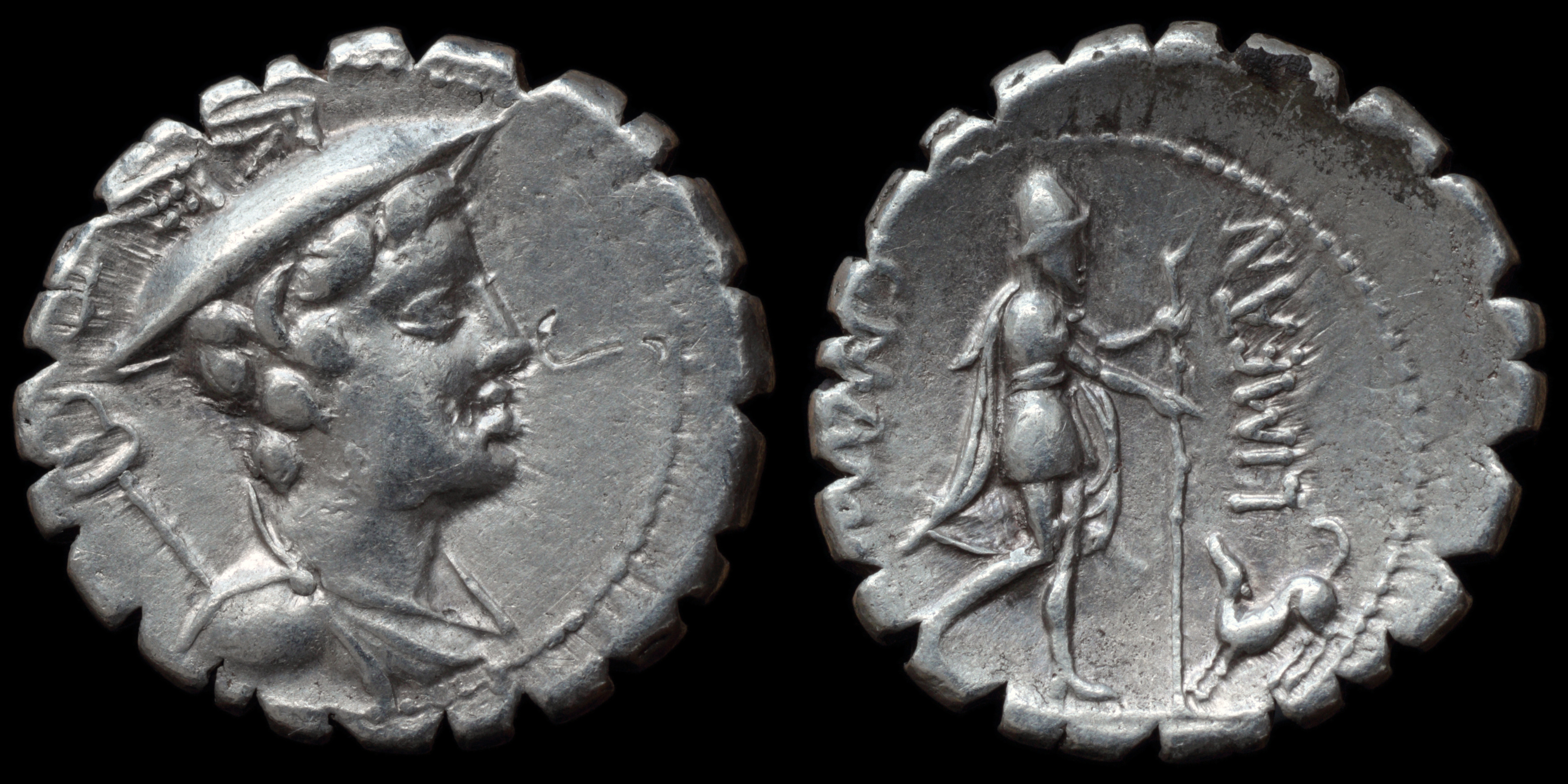
Reverse: Ulysses walking right, holding staff, dog Argus left; C·MAMIL__LIME(TA)N
Die Orientation: -
Weight: 4.1 g
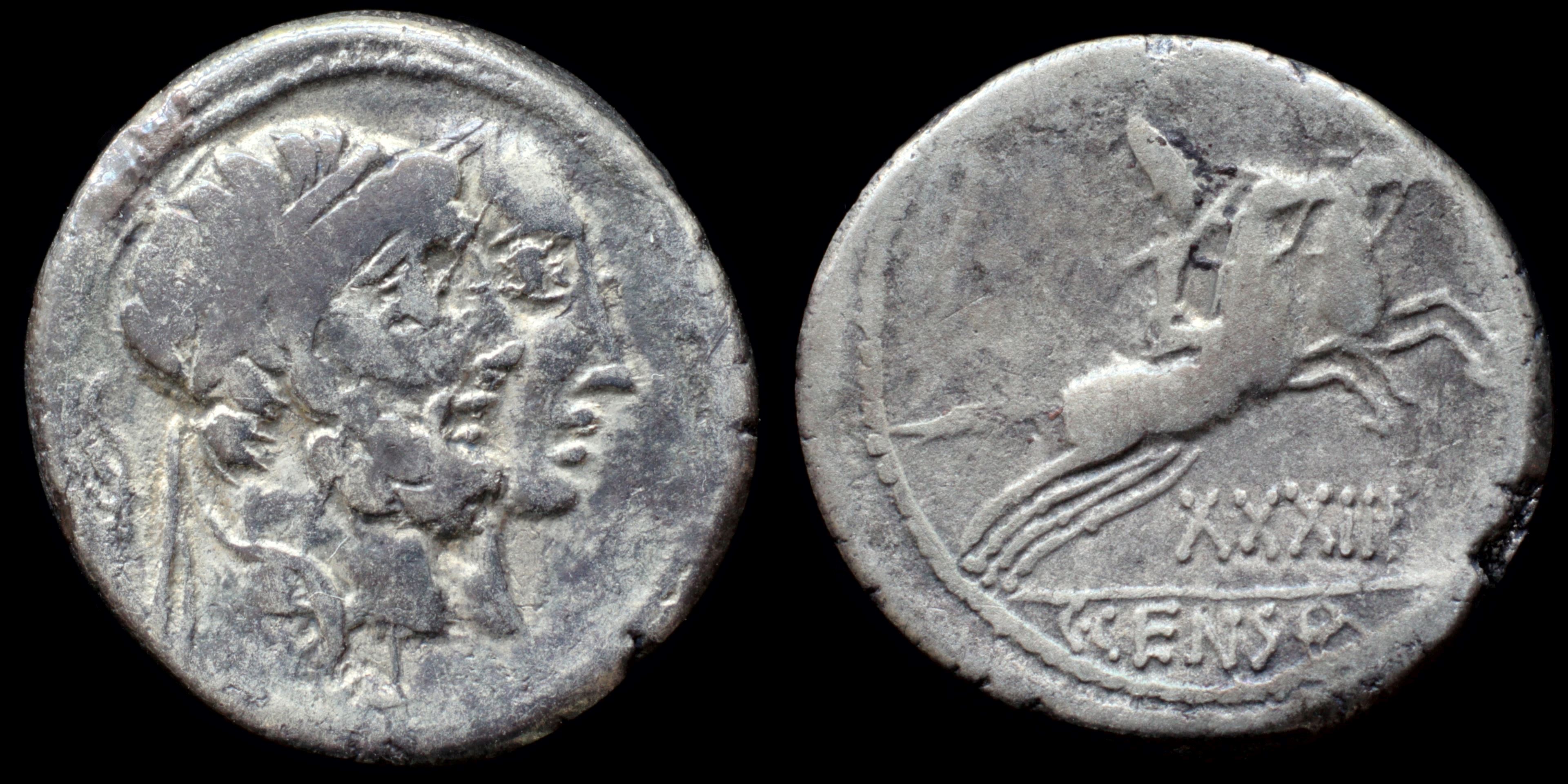
Reverse: Desultor right riding two horses, wearing conical cap, holding whip; XXXIII / C·CENSO
Die Orientation: -
Weight: 3.8 g
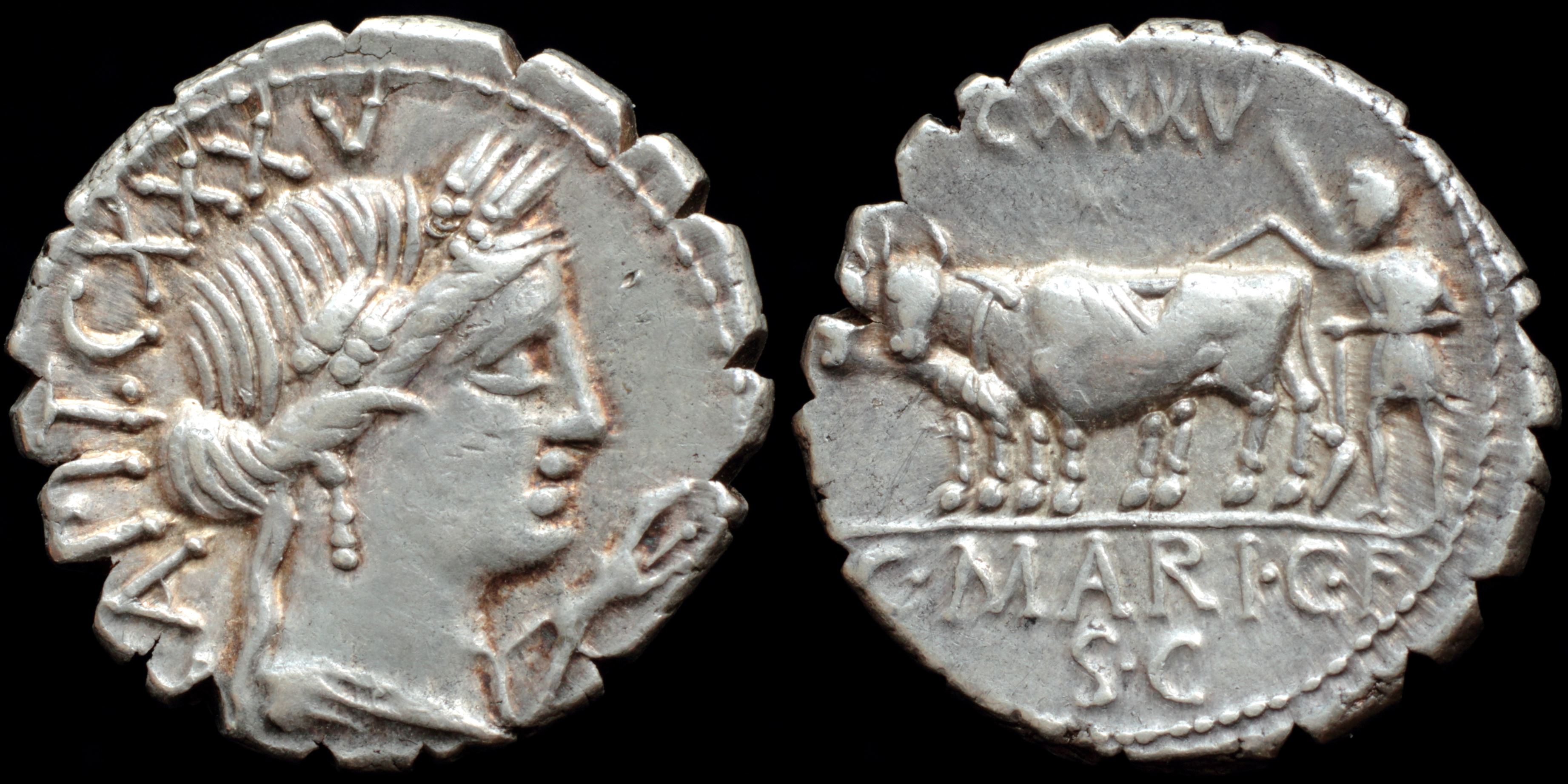
Reverse: ploughman conducting yoke of two oxen, CXXXV / C·MARI·C·F / S·C
Die Orientation: -
Weight: 4.06 g
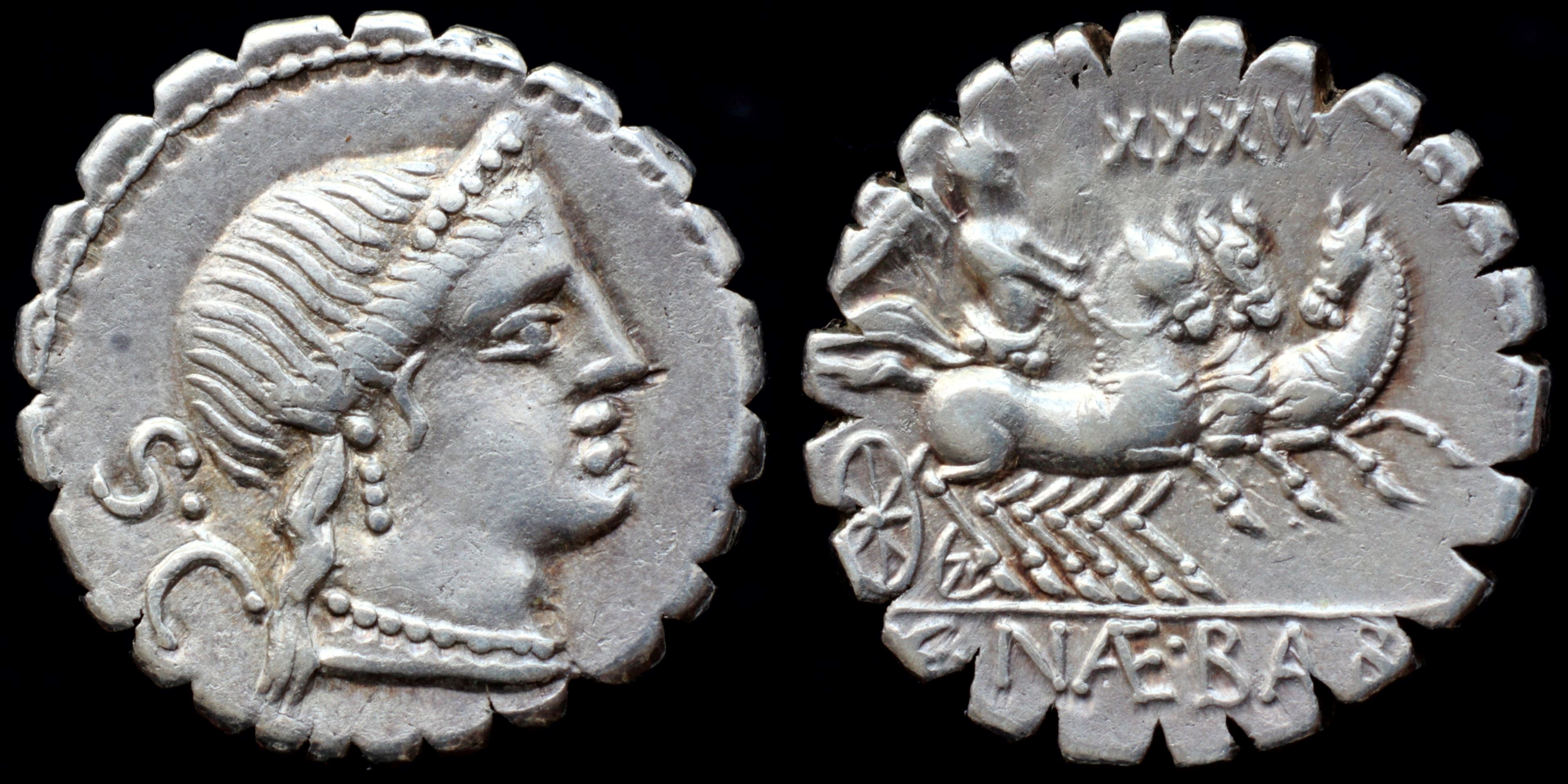
Reverse: Victory right in triga holding reins; XXXIII / C·N(AE)·B(AL)B
Die Orientation: -
Weight: 3.9 g
_2.jpg)
Reverse: Victory in triga right; C NÆ BALB in exergue
Die Orientation: 5 H
Weight: 3.91 g
(13).JPG)
Reverse: Corn ear, fasces and caduceus
Die Orientation: 12 H
Weight: 3.93 g
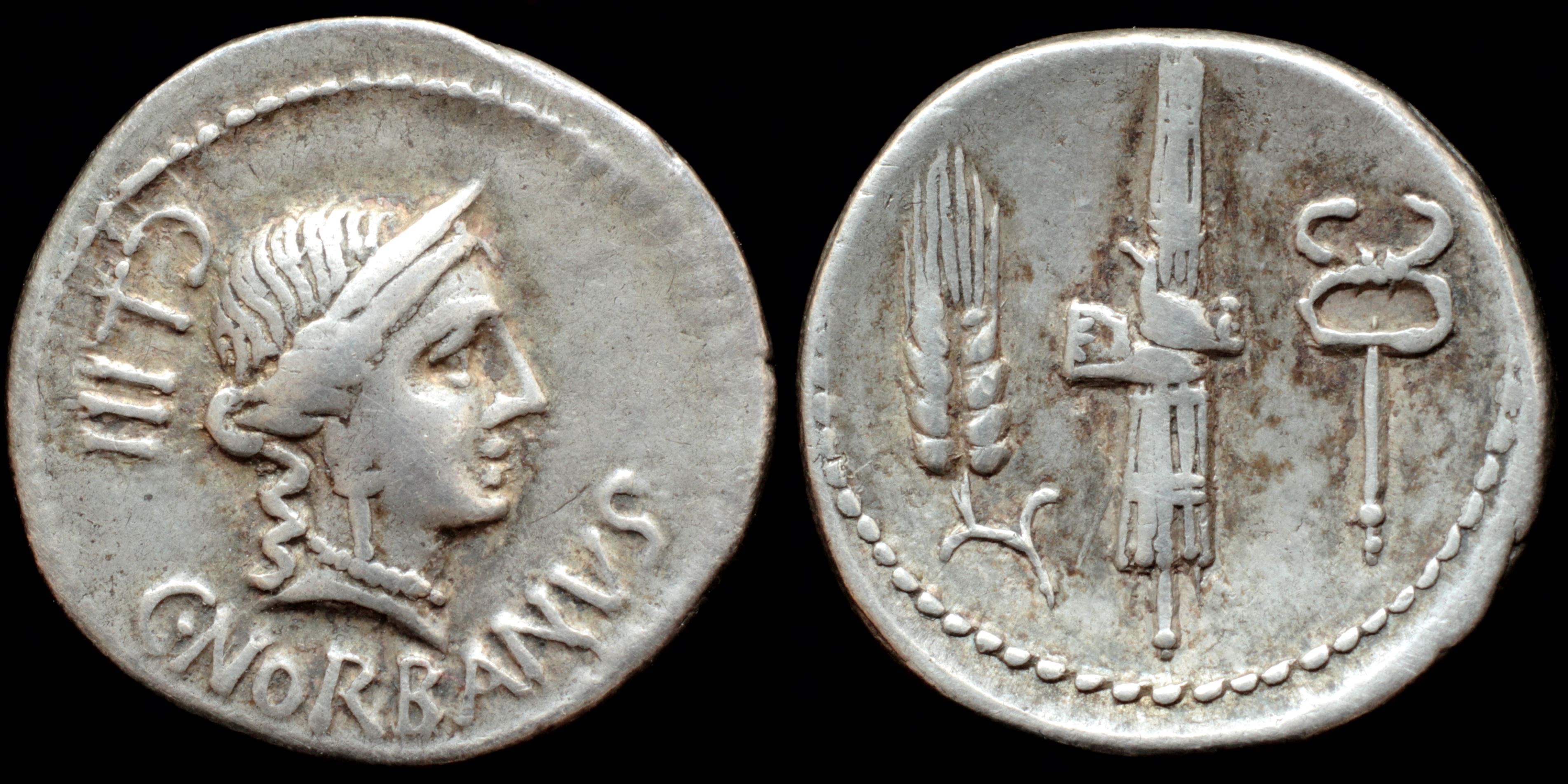
Reverse: grain ear, fasces and caduceus
Die Orientation: -
Weight: 3.9 g
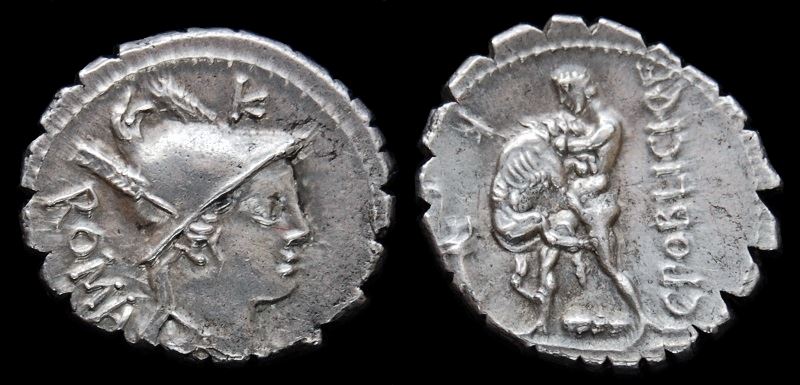
Reverse: Hercules standing left, strangling Nemean Lion; club at his feet, K (control mark) above; bow and arrows in left field; C•POBLICI•Q•F upwards in right field.
Die Orientation: 5 H
Weight: 3.9 g
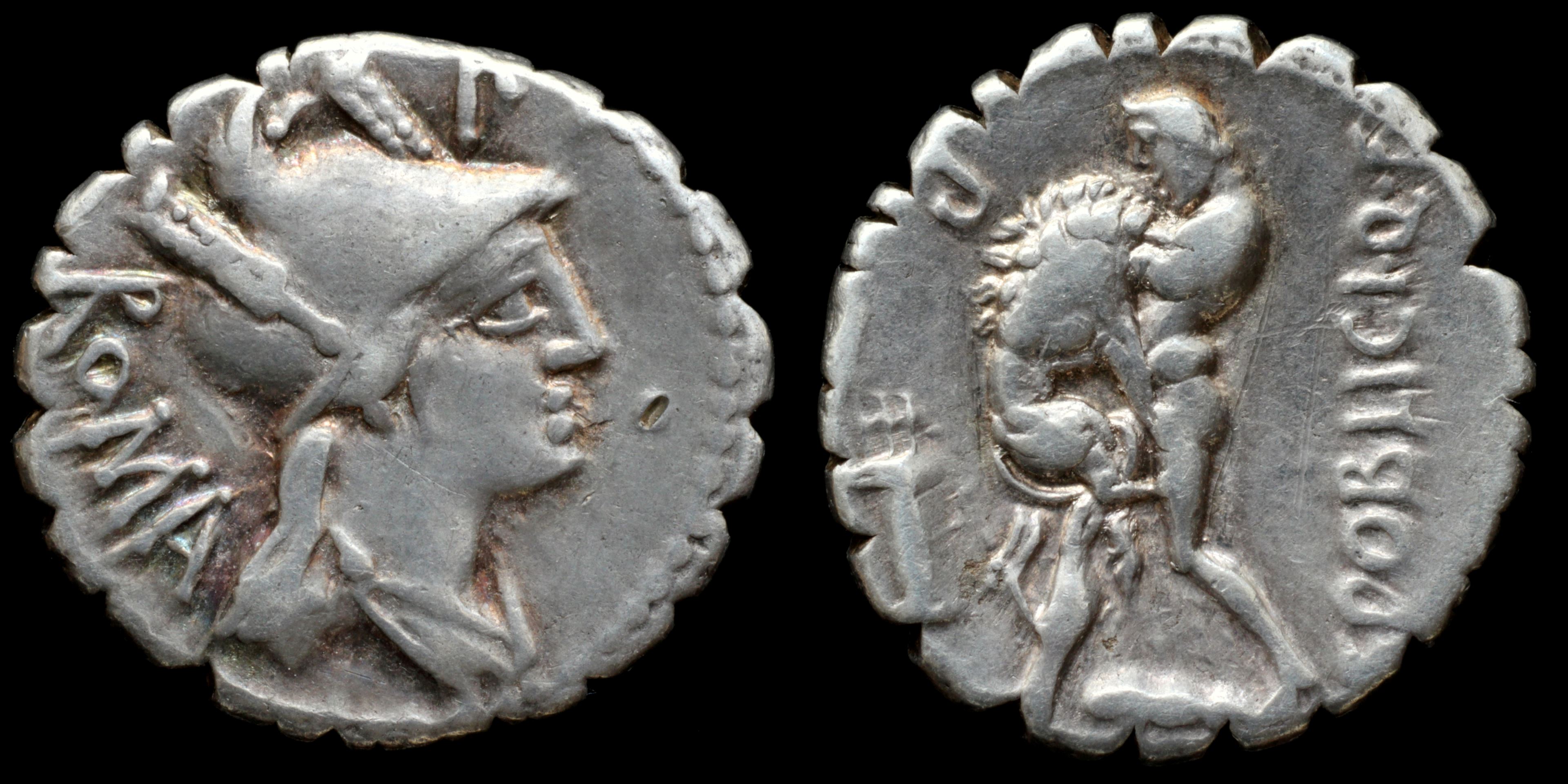
Reverse: naked Hercules left strangling Nemean lion; bow with arrows in quiver left, club below; C·POBLICI·Q·F / P
Die Orientation: -
Weight: 4 g
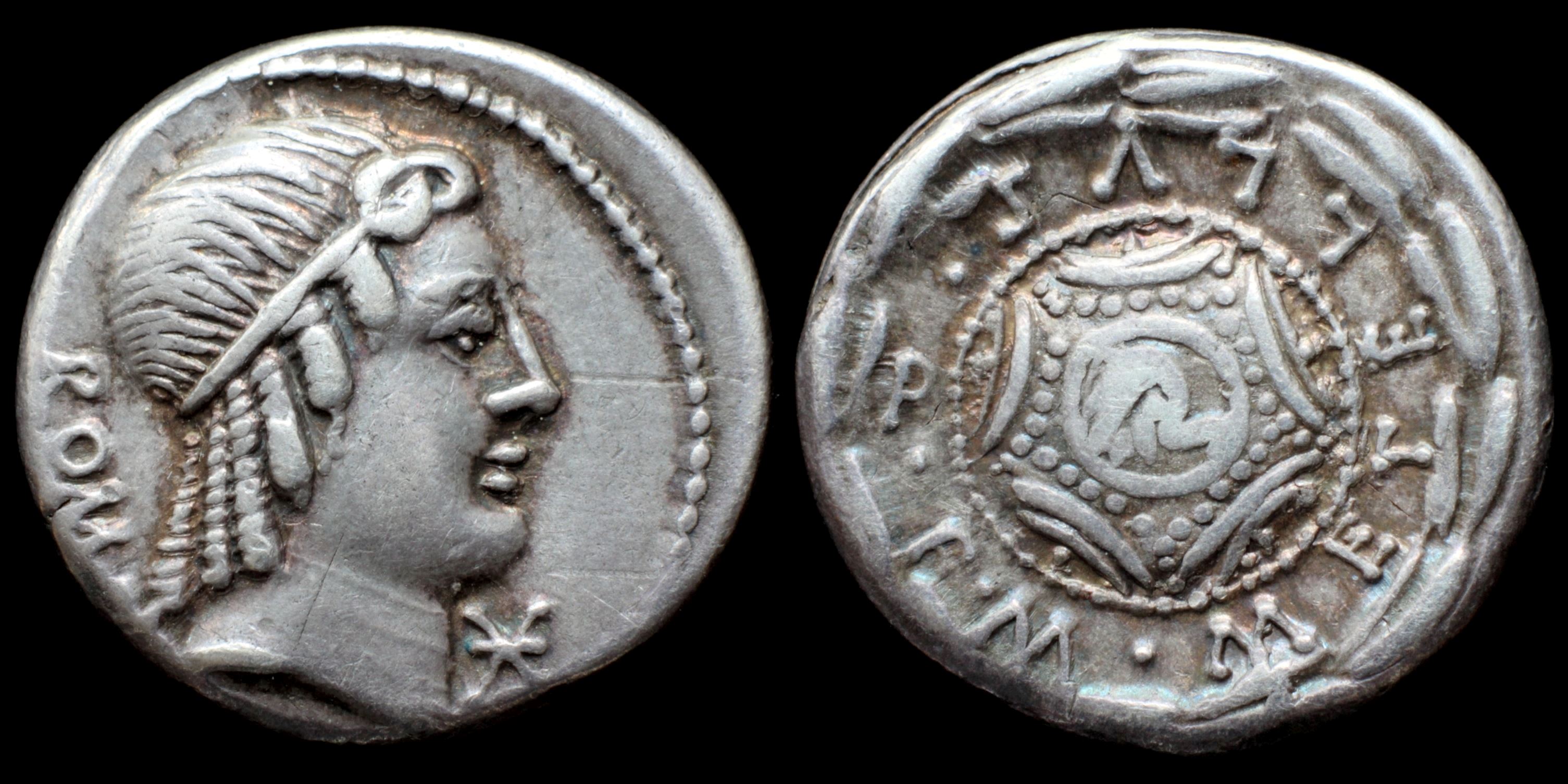
Reverse: Macedonin shield decorated with elephant head right, all within laurel wreath; M·METELLVS·Q·F·
Die Orientation: -
Weight: 3.9 g
(1).jpg)
Reverse: Victory standing right, crowning trophy; CN LENT in exergue (NT in monogram)
Die Orientation: 2 H
Weight: 1.85 g
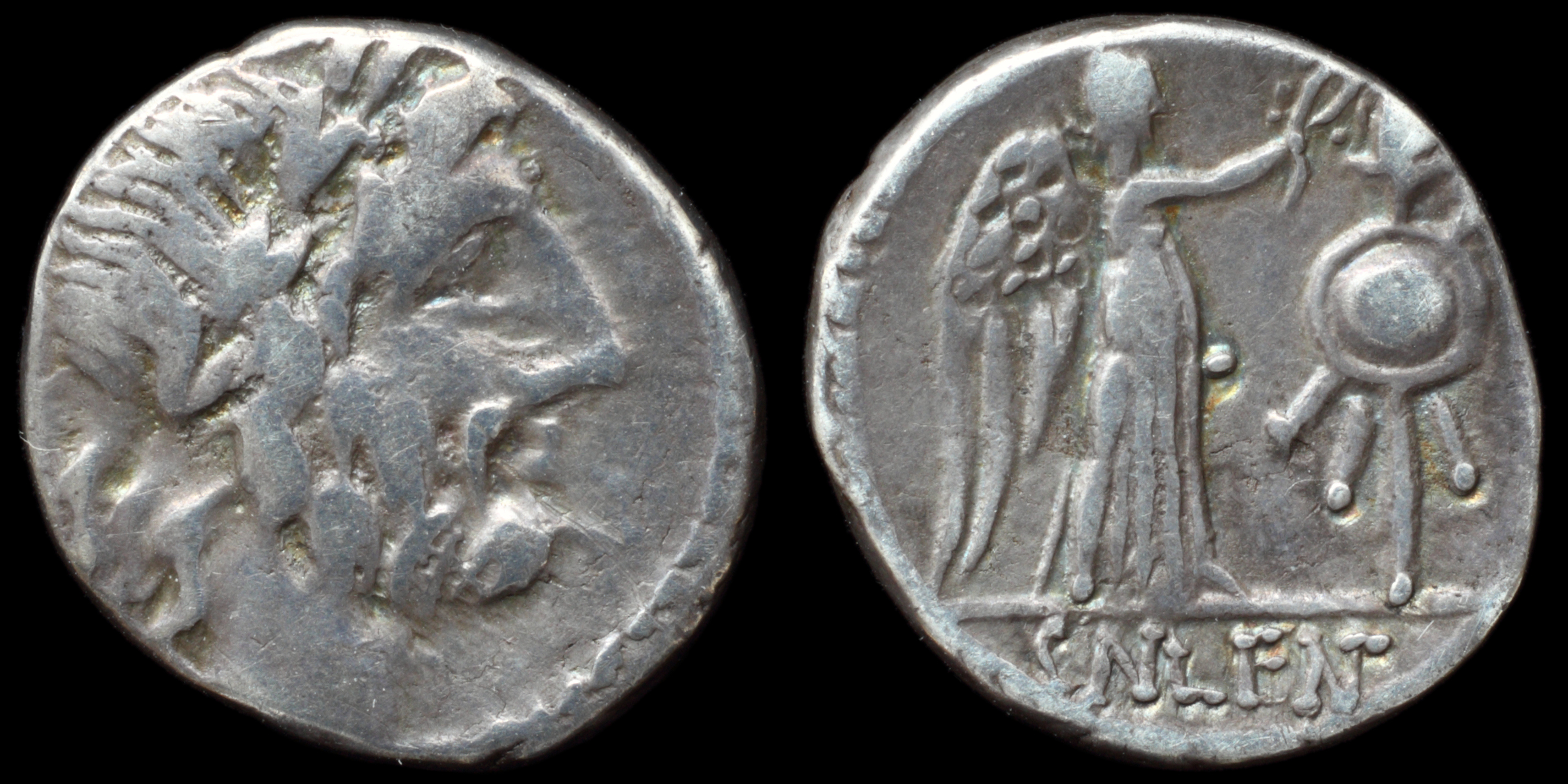
Reverse: Victory standing right, crowning trophy with wreath; CN LE(NT)
Die Orientation: -
Weight: 1.9 g
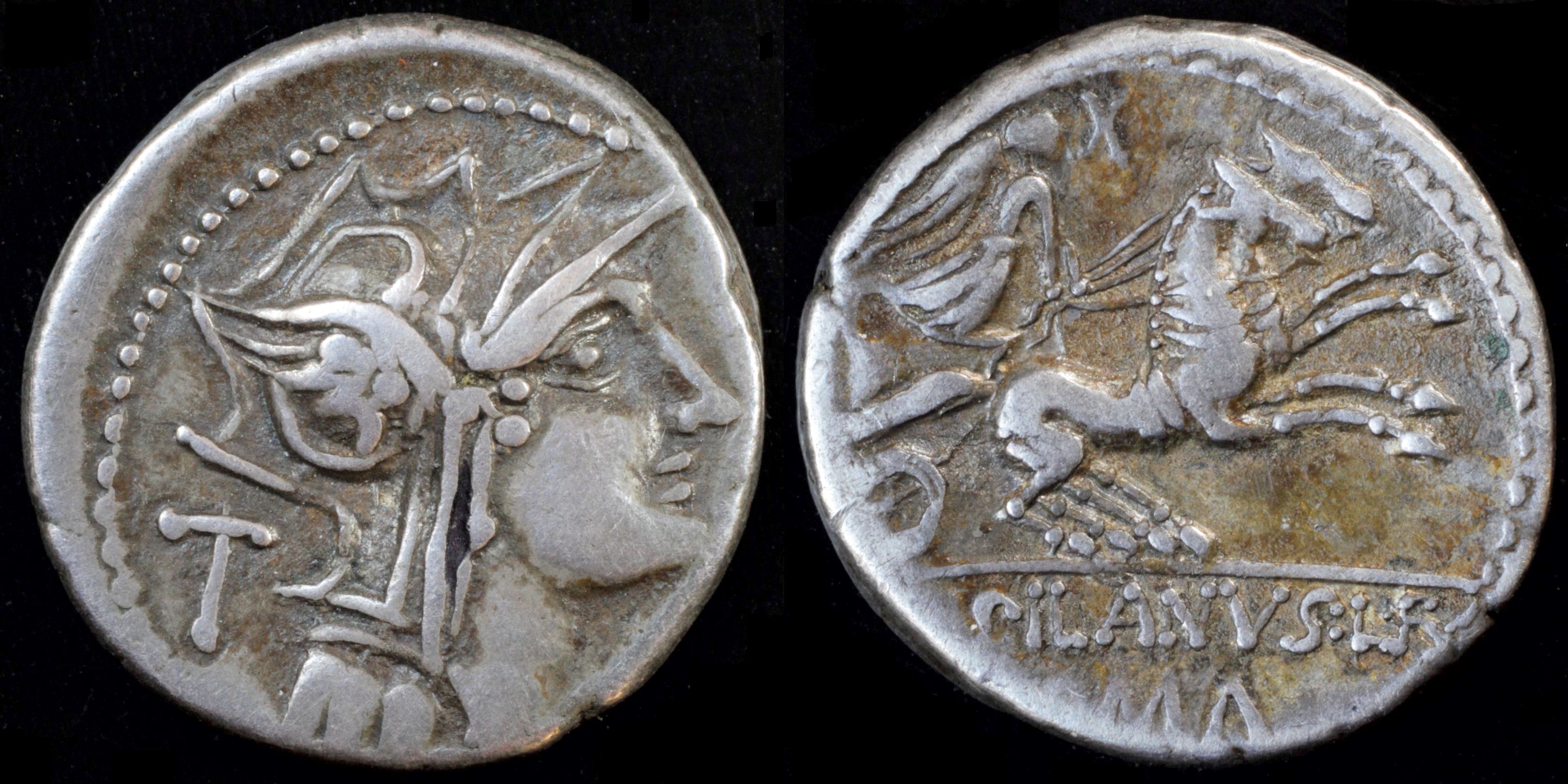
Reverse: Victory in biga galloping right X D·SILANVS·L·F / ROMA
Die Orientation: -
Weight: 4 g
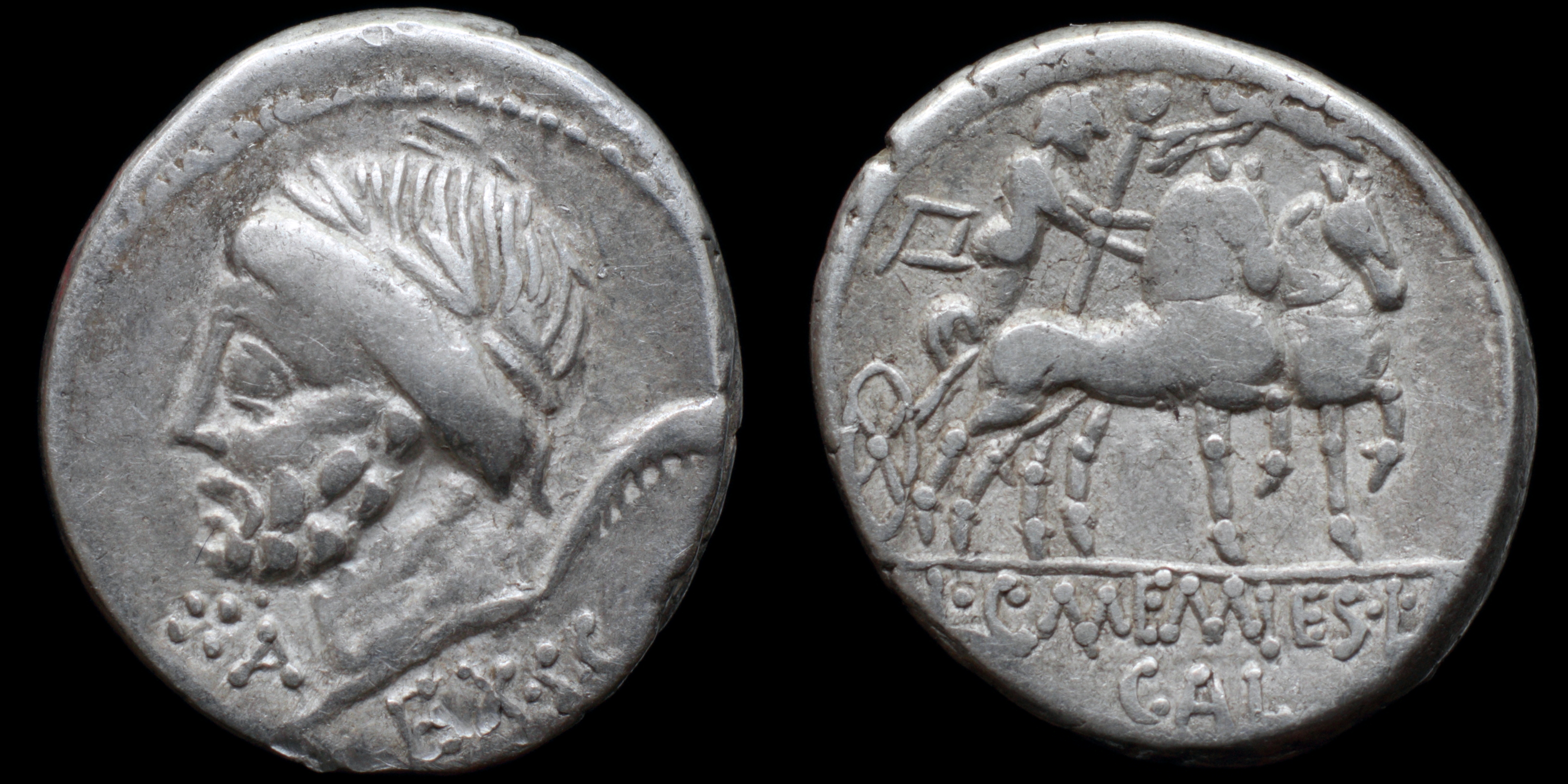
Reverse: Venus in slow biga right, holding staff and reins; above Cupid flying left, holding wreath; L·C·MEMIES·L·F / GAL
Die Orientation: -
Weight: 4 g
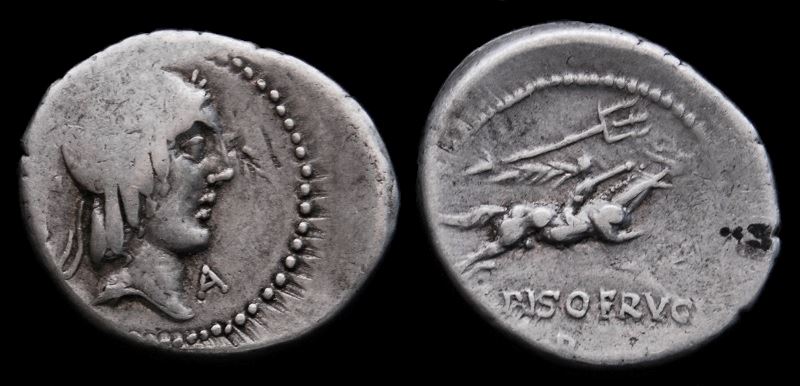
Reverse: Warrior riding horse right, holding palm frond and reins, above a trident right. L PISO FRUGI and control mark R in two lines below.
Die Orientation: 1 H
Weight: 3.9 g
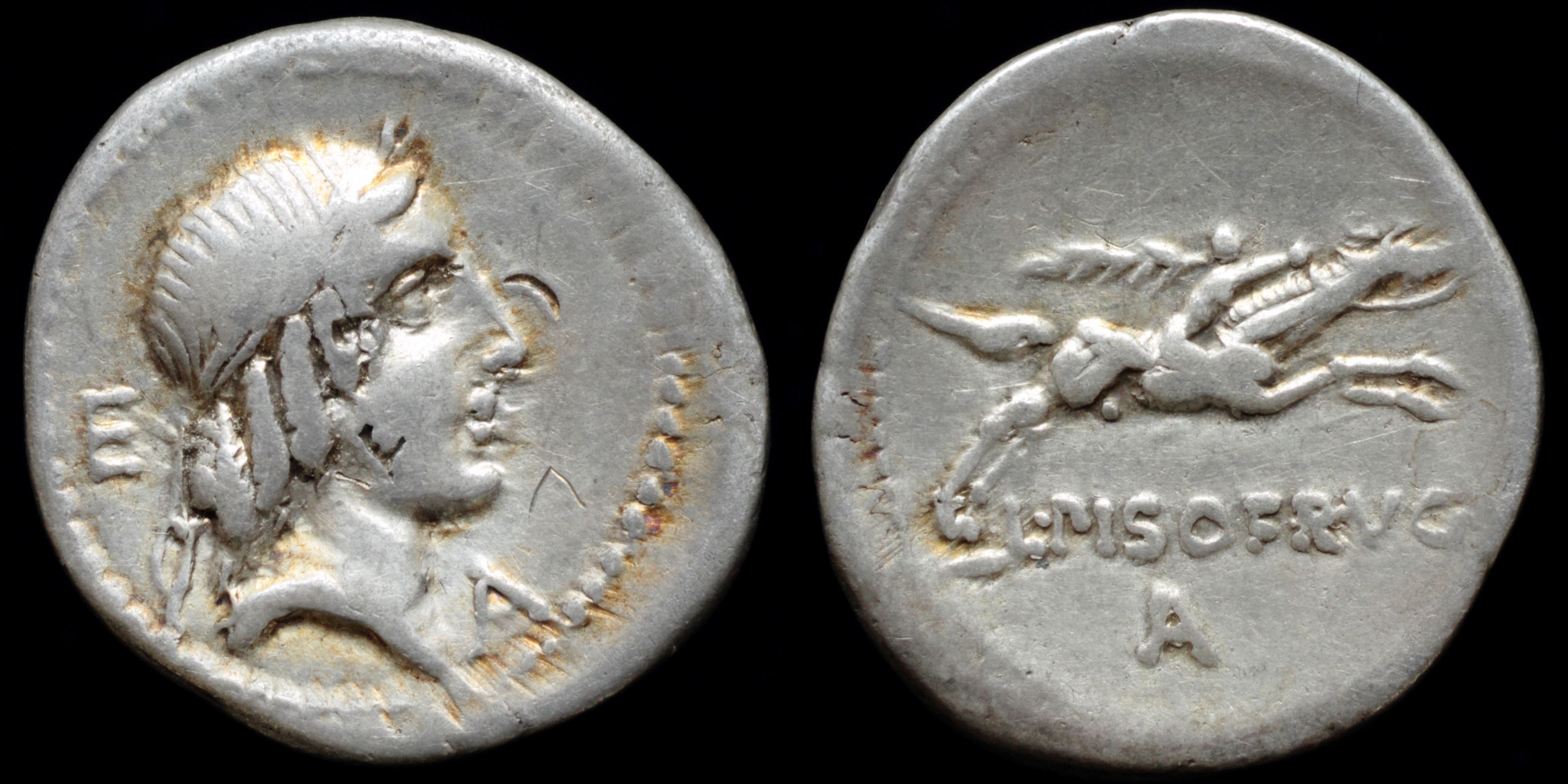
Reverse: Horseman holding palm branch galloping right L·PISO FRVGI / A
Die Orientation: -
Weight: 3.8 g

Reverse: Victory advancing right, holding wreath and palm-branch, L PI - SO across fields, FRVGI in exergue.
Die Orientation: -
Weight: 2.16 g
Provenance: Naville Numismatics, Auction 42 (22 July 2018), lot 422. Ex Sternberg Auction 18 (20 November 1986), lot 323.
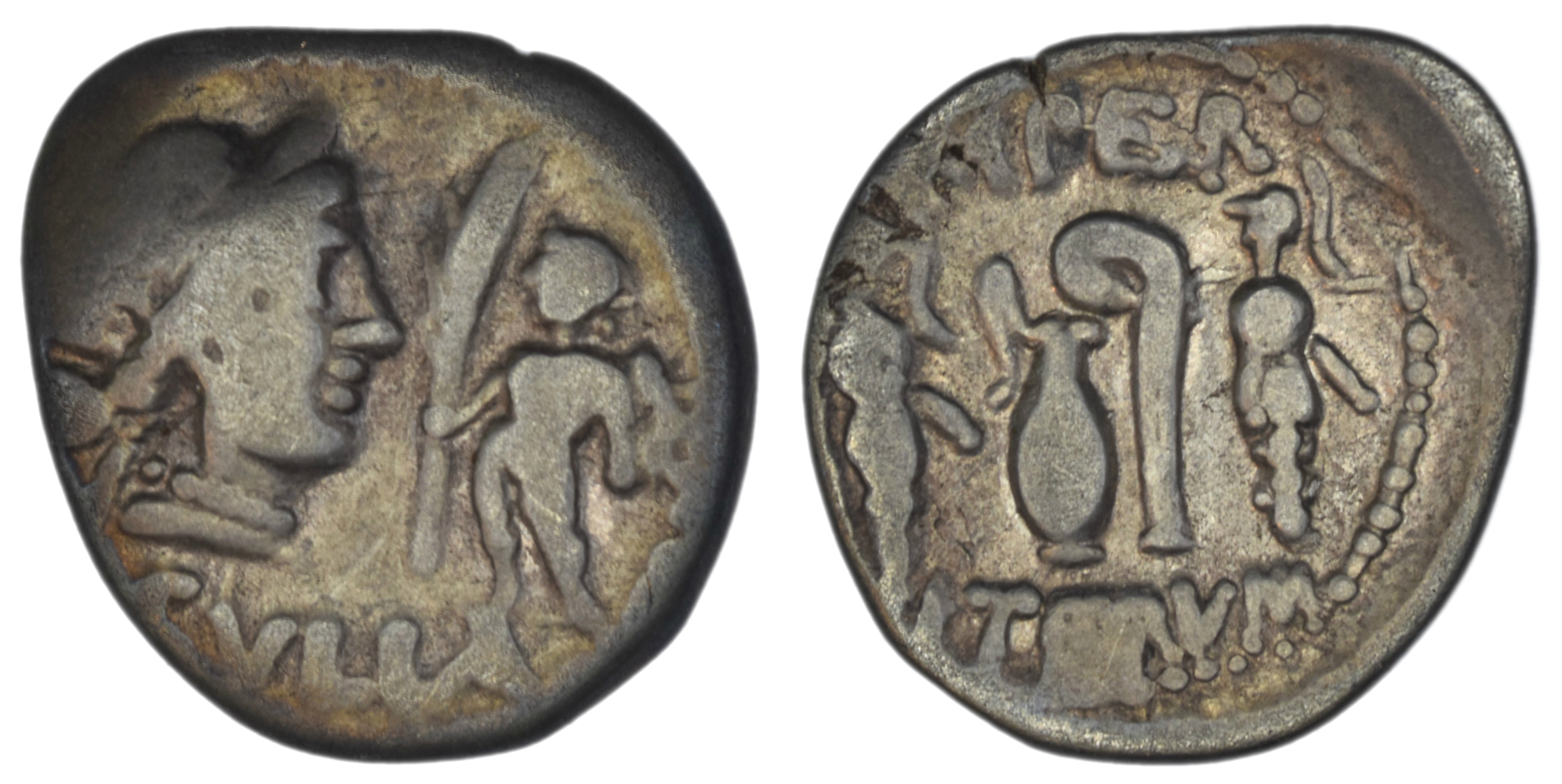
Reverse: IMPER ITERVM - Jug and Lituus between two trophies
Die Orientation: -
Weight: 3.24 g
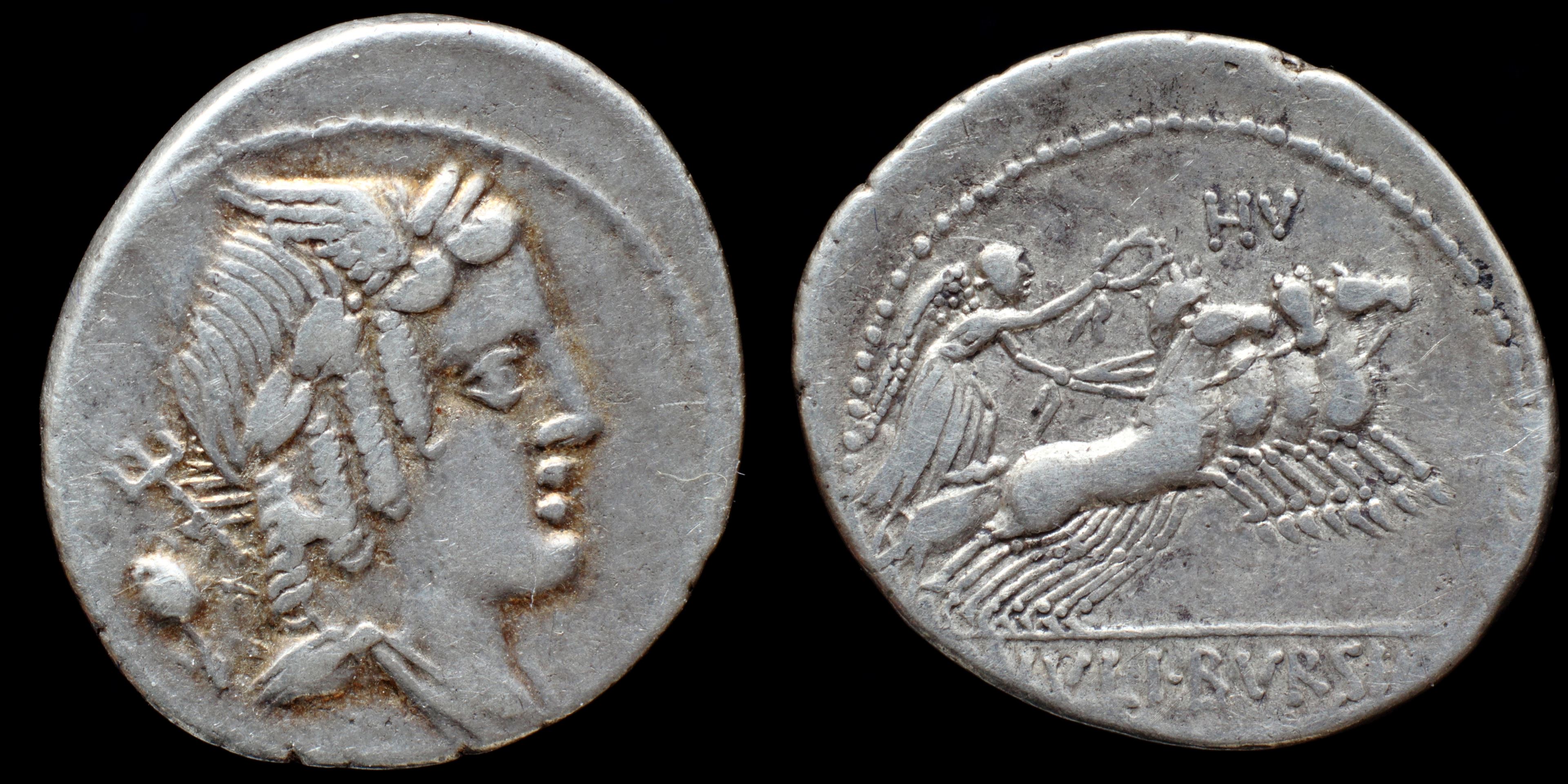
Reverse: Victory in quadriga right, holding wreath and reins; HV / L·IVLI·BVRSIO
Die Orientation: -
Weight: 3.8 g
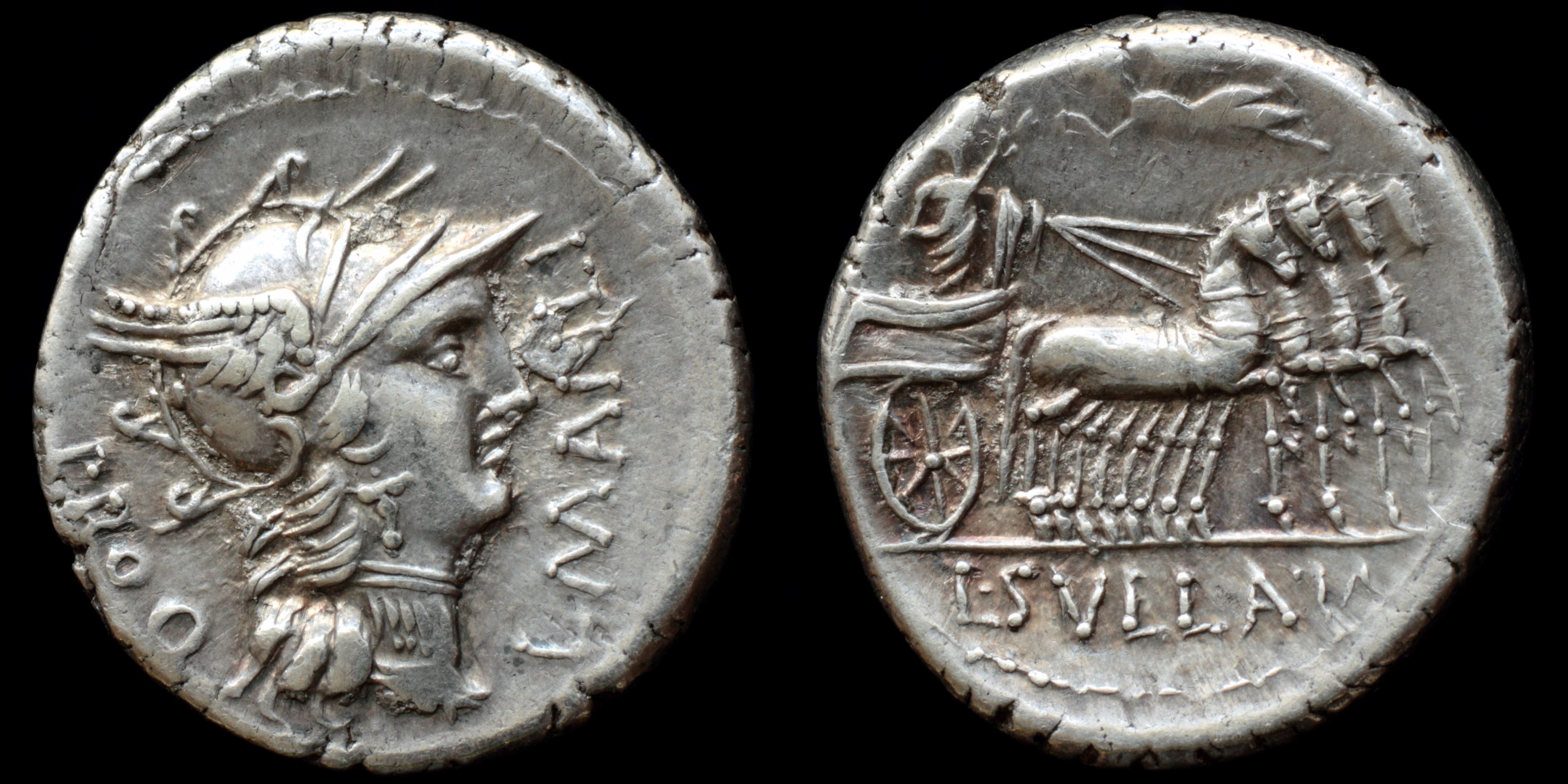
Reverse: Sulla right in quadriga holding caduceus and reins, Victory flying right holding wreath L·SVLLA·IM
Die Orientation: -
Weight: 3.9 g
mint in south Italy. Reverse depicts Sulla's upcoming triumph which was held on 29-30 Janury 81 BC.
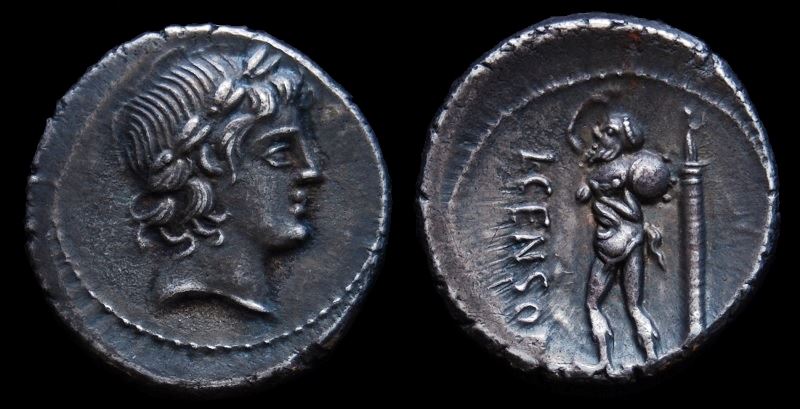
Reverse: Marsyas standing left, raising hand and holding wineskin over shoulder; L•CENSOR downwards in left field; column surmounted by statue of Minerva(?) in right field.
Die Orientation: 6 H
Weight: 3.46 g
"Among the Romans, Marsyas was cast as the inventor of augury and a proponent of free speech (the philosophical concept "parrhesia") and "speaking truth to power." The earliest known representation of Marsyas at Rome stood for at least 300 years in the Roman Forum near or in the comitium, the space for political activity. He was depicted as a silen, carrying a wineskin on his left shoulder and raising his right arm. The statue was regarded as an indicium libertatis, a symbol of liberty, and was associated with demonstrations of the plebs, or common people. It often served as a sort of kiosk upon which invective verse was posted."
"The plebeian gens of the Marcii claimed that they were descended from Marsyas. Gaius Marcius Rutilus, who rose to power from the plebs, is credited with having dedicated the statue that stood in the Roman forum, most likely in 294 BC, when he became the first plebeian censor and added the cognomen Censorinus to the family name. Marcius Rutilus was also among the first plebeian augurs, co-opted into their college in 300, and so the mythical teacher of augury was an apt figure to represent him."
"The descendant of Marcius Rutilus, L. Marcius Censorinus, issued coins depicting the statue of Marsyas, at a time when the augural college was the subject of political controversy during the Sullan civil wars of the 80s BC. On the coin, Marsyas wears a Phrygian cap or pilleus, an emblem of liberty. This Marcius Censorinus was killed by Sulla and his head displayed outside Praeneste. Sulla's legislative program attempted to curtail power invested in the people, particularly restricting the powers of the plebeian tribunes, and to restore the dominance of the senate and the privileges of patricians."
Provenance: CNG 106 (13 September 2017), lot 649.
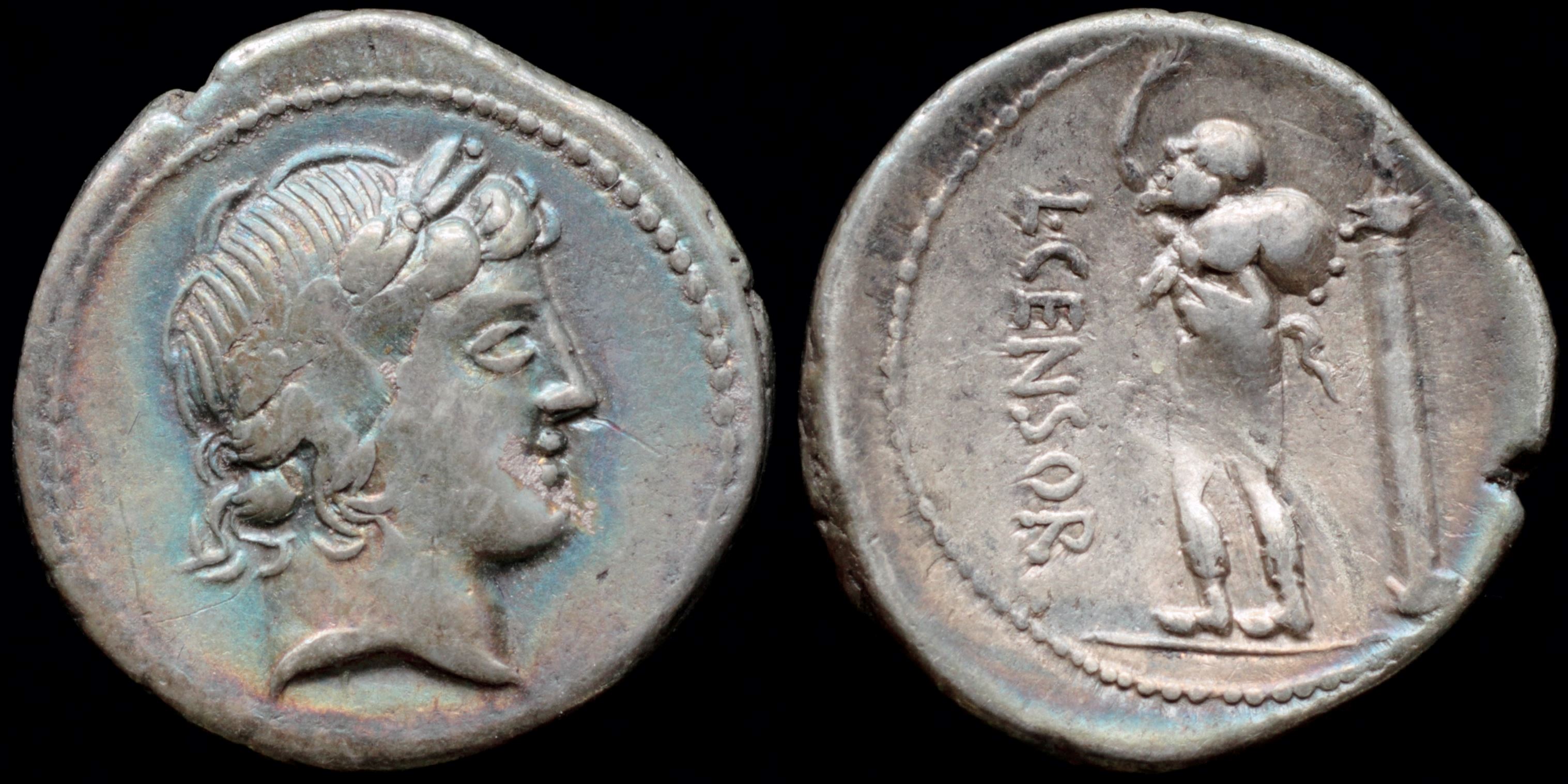
Reverse: Marsyas standing left, rising hand, holding with wine skin over shoulder; column topped with Victory behind L·CENSOR
Die Orientation: -
Weight: 3.8 g
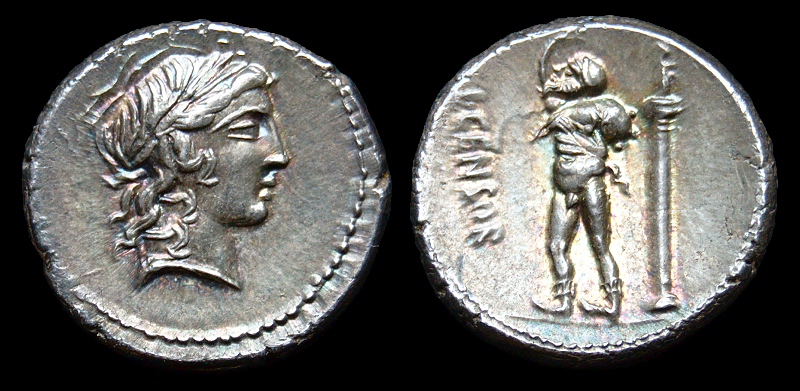
Reverse: Marsyas standing left, raising hand and holding wineskin over shoulder; L•CENSOR downwards in left field; column surmounted by statue of Minerva(?) in right field
Die Orientation: -
Weight: 3.99 g
Among the Romans, Marsyas was cast as the inventor of augury and a proponent of free speech (the philosophical concept "parrhesia") and "speaking truth to power." The earliest known representation of Marsyas at Rome stood for at least 300 years in the Roman Forum near or in the comitium, the space for political activity. He was depicted as a silen, carrying a wineskin on his left shoulder and raising his right arm. The statue was regarded as an indicium libertatis, a symbol of liberty, and was associated with demonstrations of the plebs, or common people. It often served as a sort of kiosk upon which invective verse was posted."
The plebeian gens of the Marcii claimed that they were descended from Marsyas. Gaius Marcius Rutilus, who rose to power from the plebs, is credited with having dedicated the statue that stood in the Roman forum, most likely in 294 BC, when he became the first plebeian censor and added the cognomen Censorinus to the family name. Marcius Rutilus was also among the first plebeian augurs, co-opted into their college in 300, and so the mythical teacher of augury was an apt figure to represent him.
The descendant of Marcius Rutilus, L. Marcius Censorinus, issued coins depicting the statue of Marsyas, at a time when the augural college was the subject of political controversy during the Sullan civil wars of the 80s BC. On the coin, Marsyas wears a Phrygian cap or pilleus, an emblem of liberty. This Marcius Censorinus was killed by Sulla and his head displayed outside Praeneste. Sulla's legislative program attempted to curtail power invested in the people, particularly restricting the powers of the plebeian tribunes, and to restore the dominance of the senate and the privileges of patricians."
Provenance: CNG 111 (29 May 2019), lot 613. From the Alan J. Harlan Collection, purchased from Edward J. Waddell, Ltd.
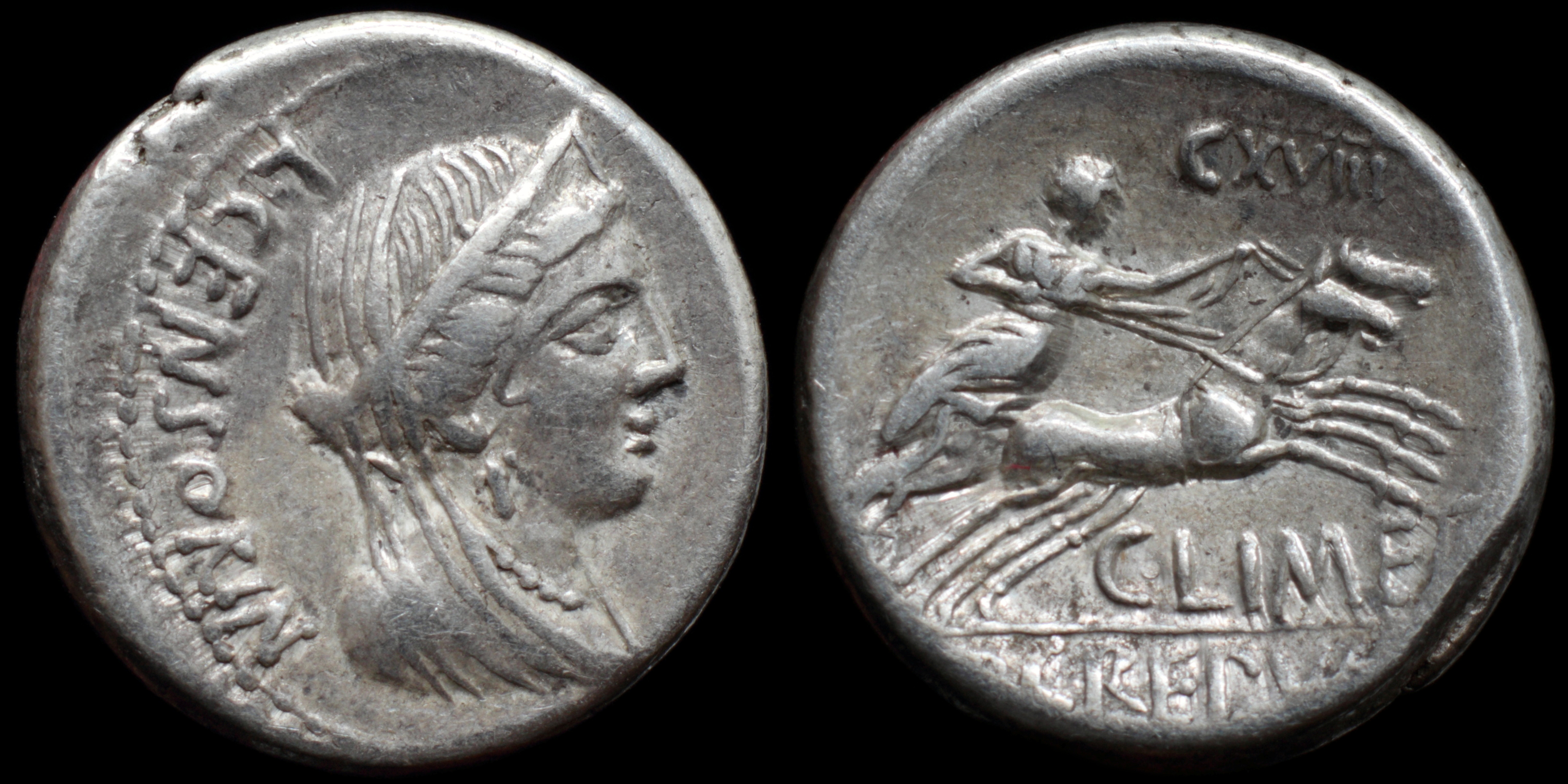
Reverse: Venus in biga right holding reins and goad; CXVIII / C·LIME(TA) / P·CREPVSI
Die Orientation: -
Weight: 3.8 g
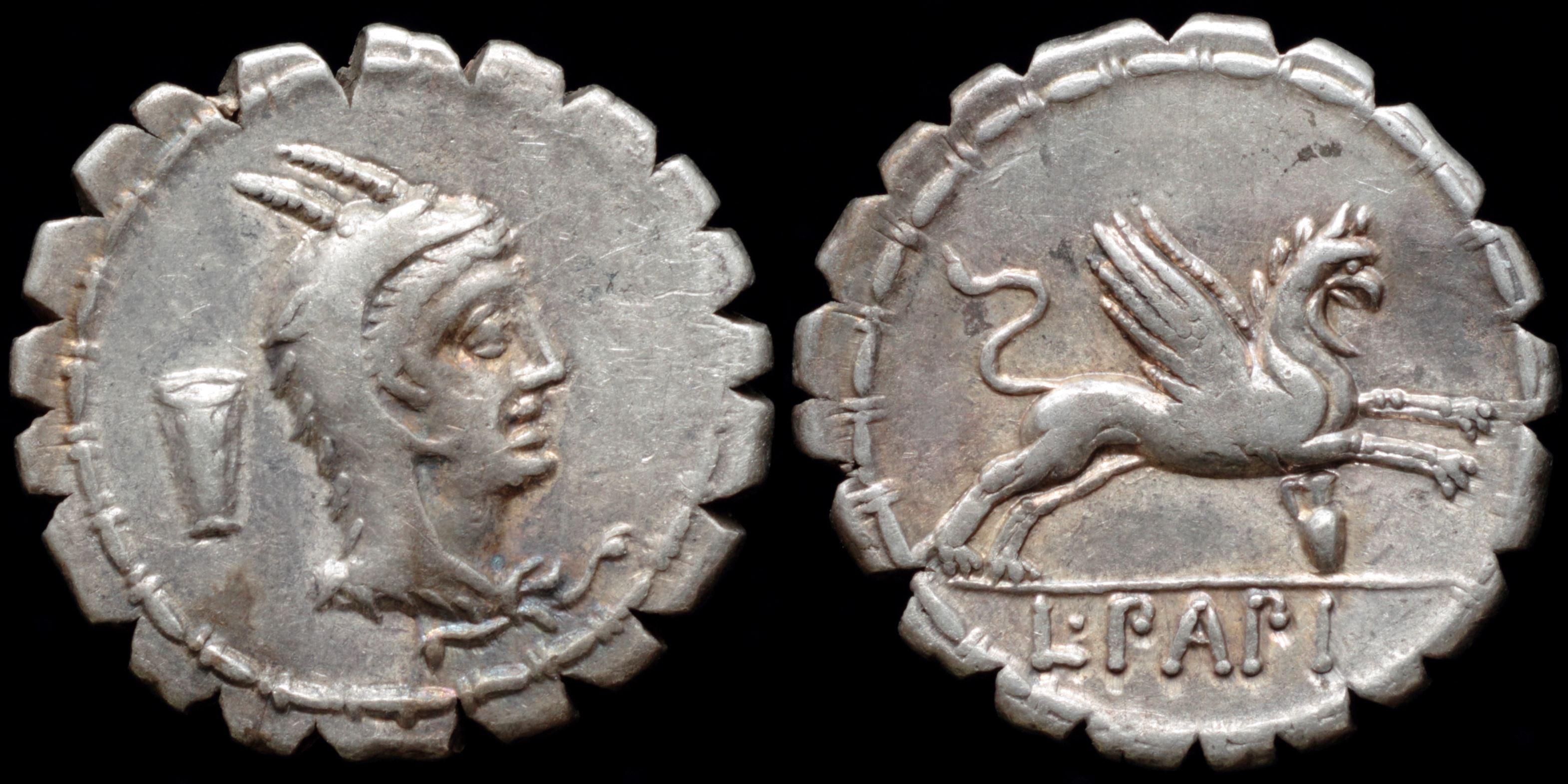
Reverse: Gryphon springing right; jug below L.PAPI
Die Orientation: -
Weight: 4 g
Gens Papia was Samnite origin and family came from Lanuvium.
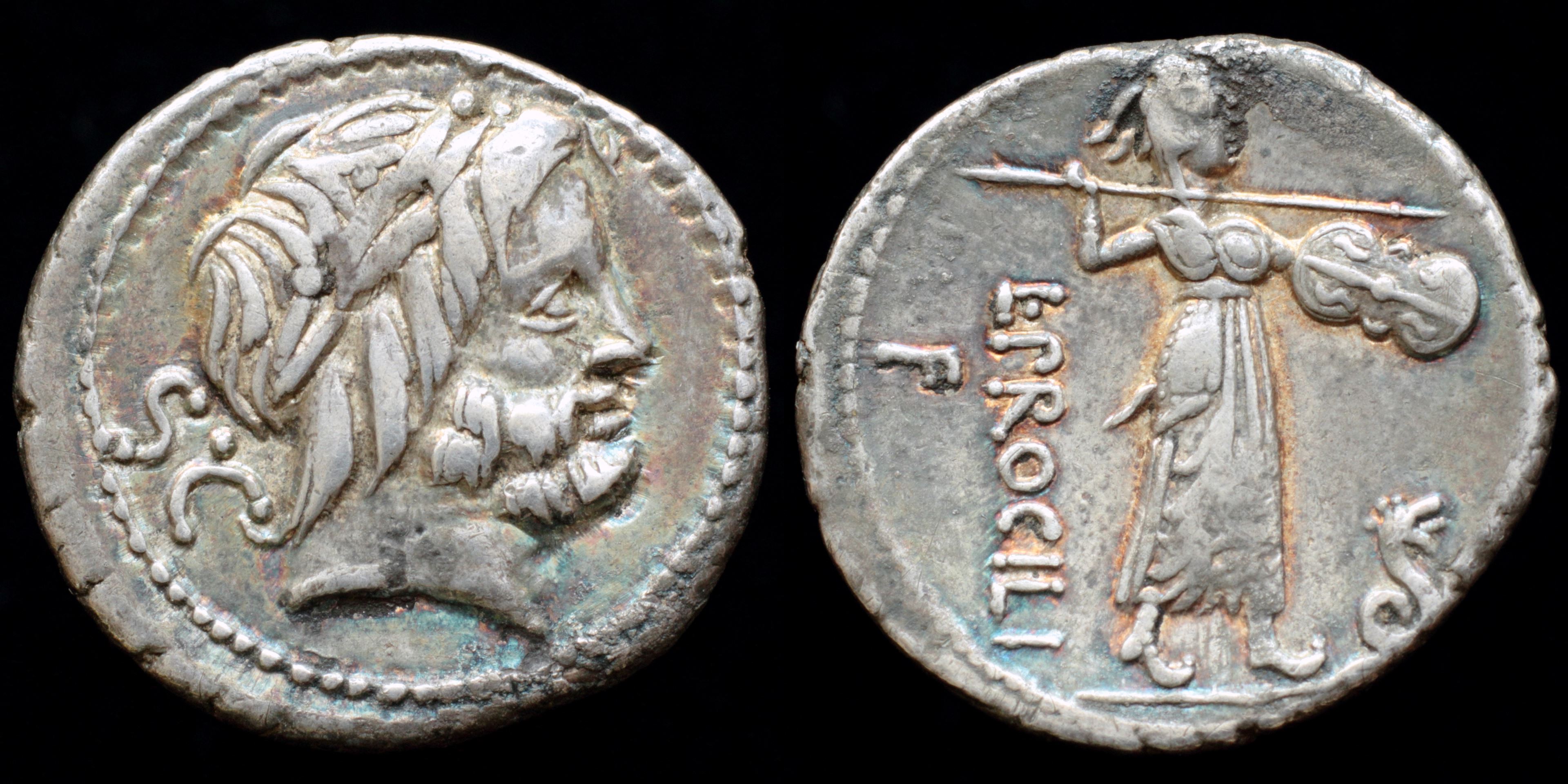
Reverse: Juno Sospita standing right, wearing goat skin, holding spear and shield; snake to the right, L.PROCILI / F
Die Orientation: -
Weight: 3.8 g
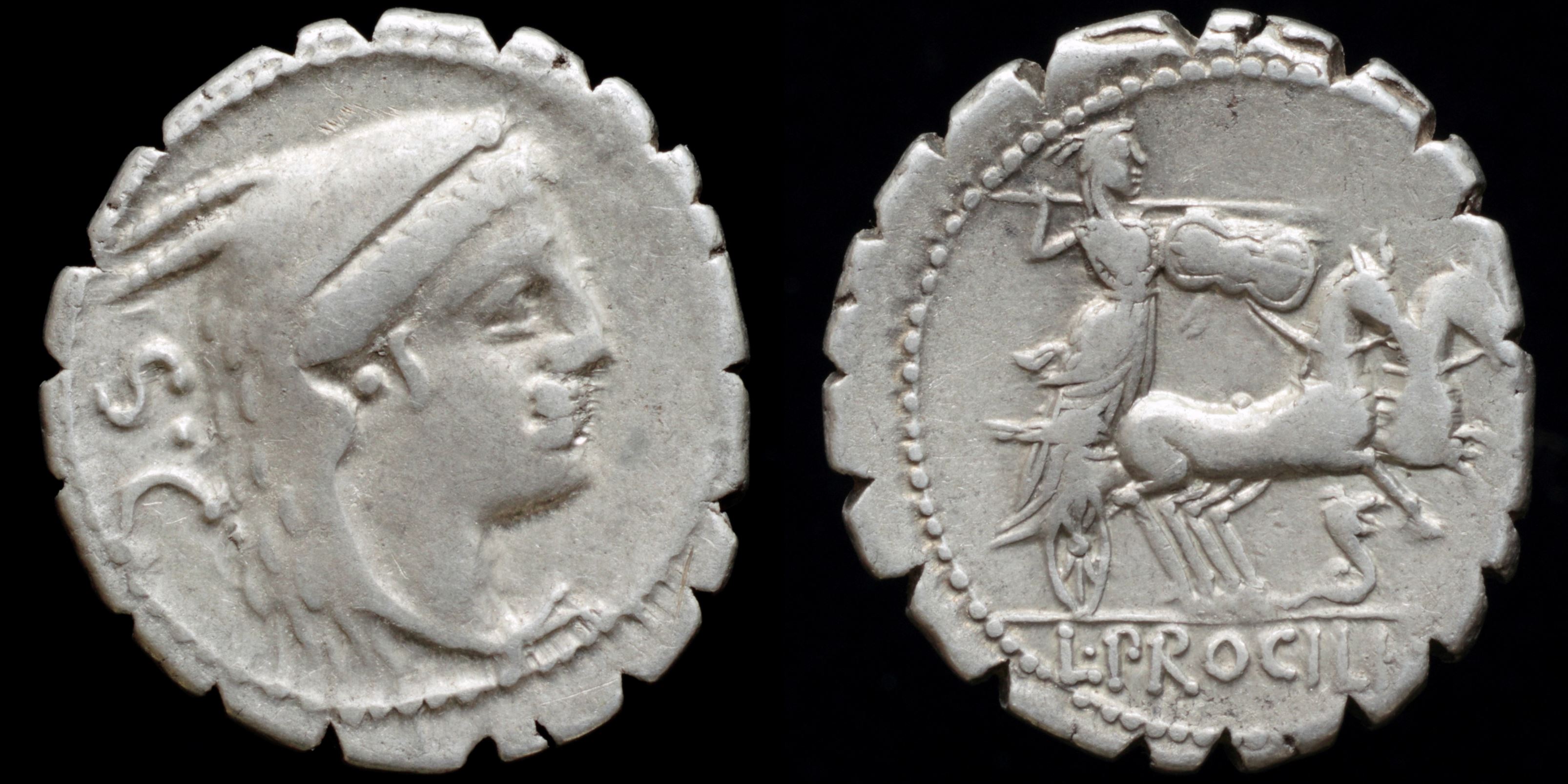
Reverse: Juno Sospita in biga right holding spear, reins and shield, snake below, L.PROCILI.F
Die Orientation: -
Weight: 3.9 g
Juno Sospita offered protection to women, accompanying them throughout their lives from birth to death. She was often called upon by infertile women to aid in conception. Juno Sospita had a two temples at Rome, but her most famous temple was at Lanuvium. Her statue there, as described by Cicero and as depicted on coinage, wore a goatskin coat with a goat-horned headdress. Her attribute, the serpent, inhabited a grotto near her temple, and was fed annually by a young girl, who, if a virgin, escaped unharmed, but if not, was destroyed.
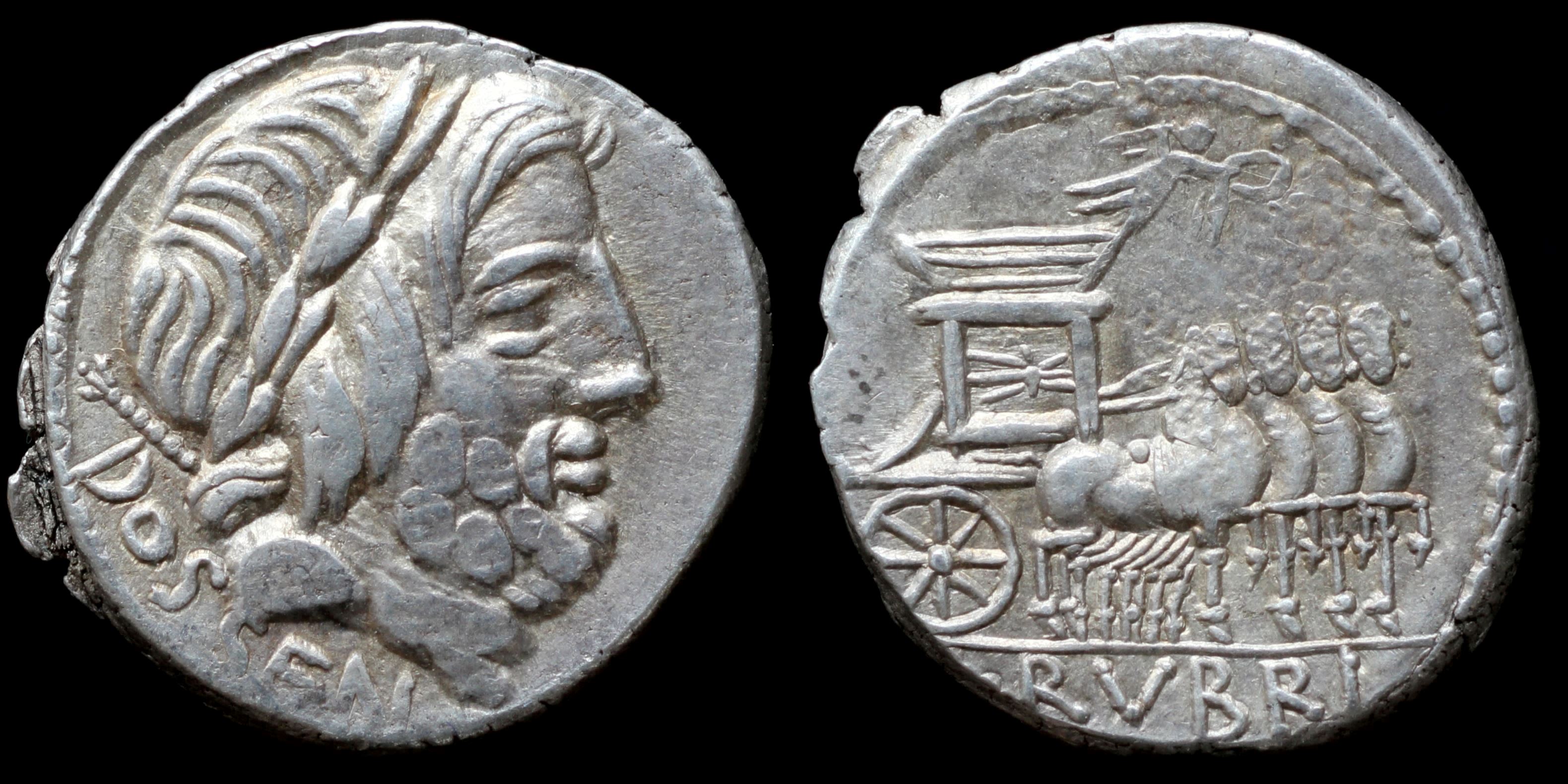
Reverse: Triumphal chariot with thunderbolt as decoration on side panel decorated; Victory flying right above chariot, holding wreath L.RVBRI
Die Orientation: -
Weight: 3.95 g
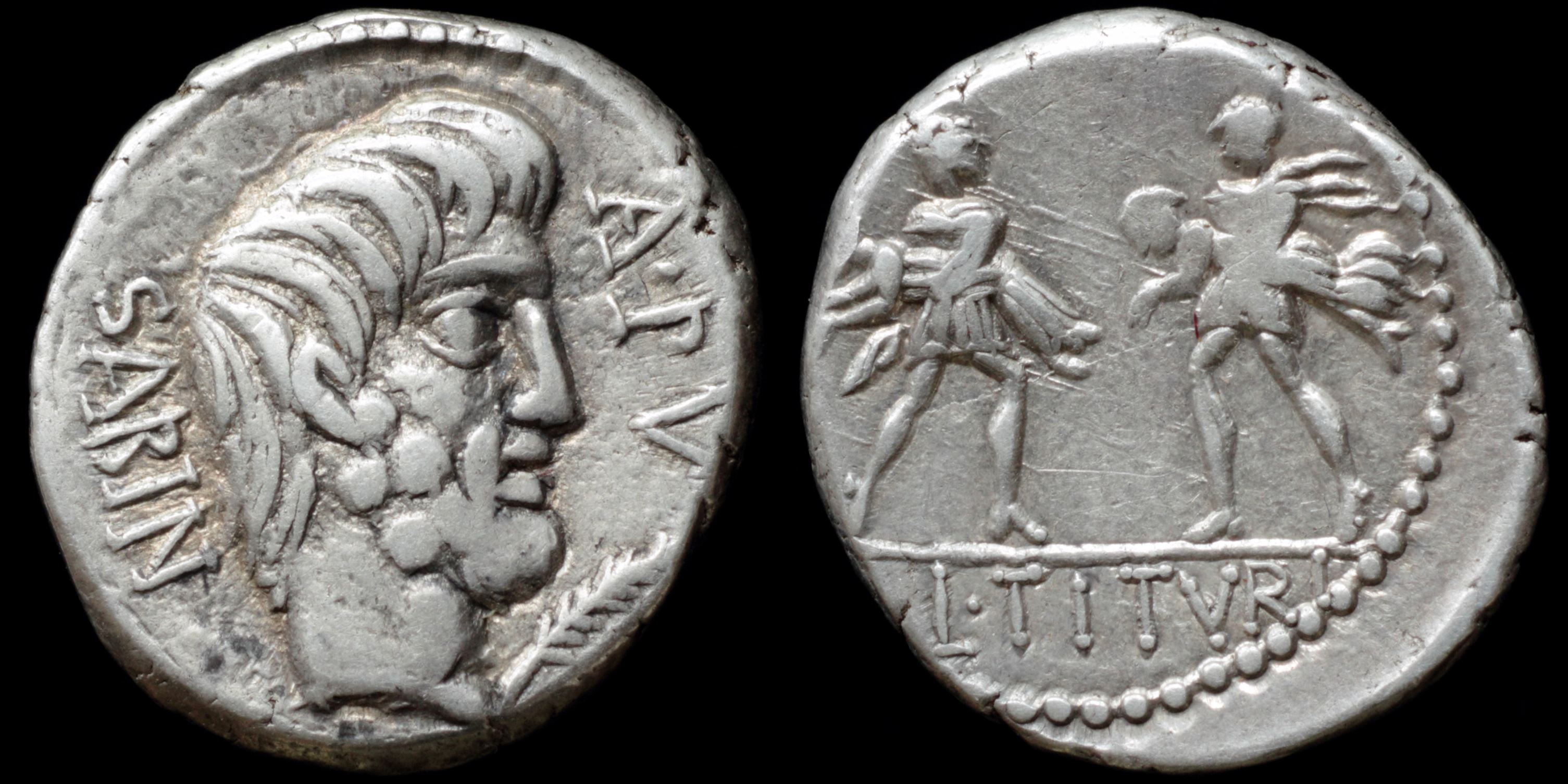
Reverse: two Roman soldiers running left, each bearing a Sabine woman in his arms L·TITVRI
Die Orientation: -
Weight: 4.2 g
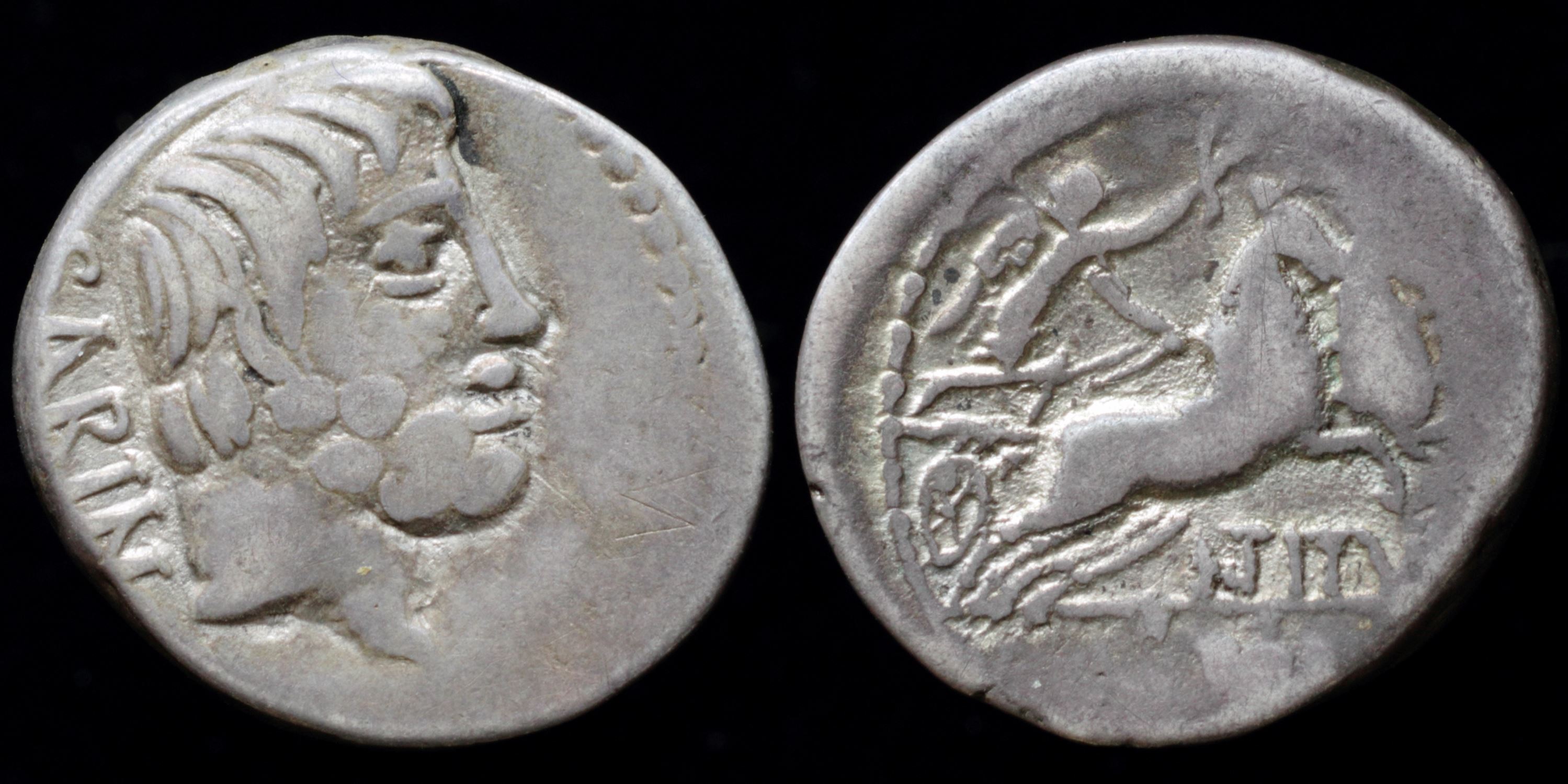
Reverse: Victory in biga right holding wreath and reins L·TITVRI, controlmark in exergue (trophy?)
Die Orientation: -
Weight: 3.91 g
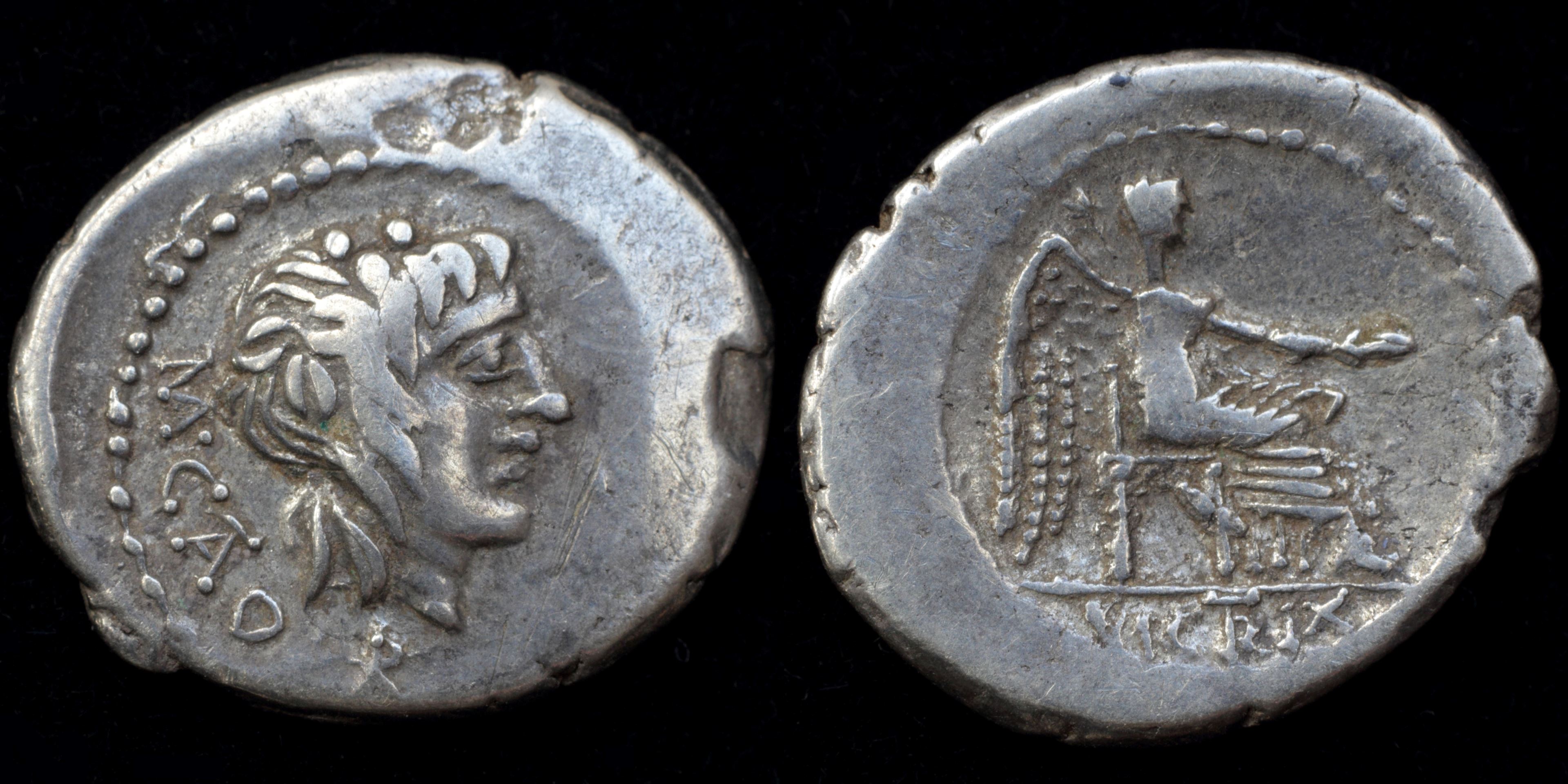
Reverse: Victory seated right, holding patera and palm VIC(TR)IX
Die Orientation: -
Weight: 2 g
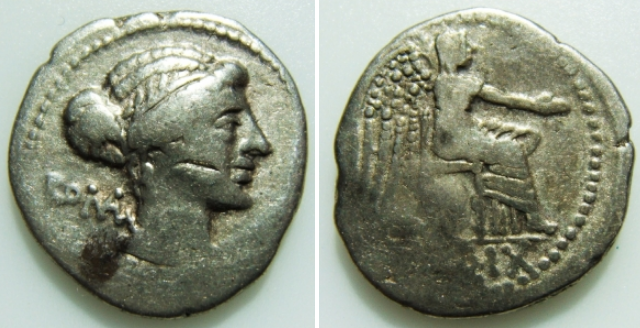
Reverse: VICTRIX - Victoria Virgo seated right, holding patera, VICTRIX in ex.
Die Orientation: 11 H
Weight: 3.72 g
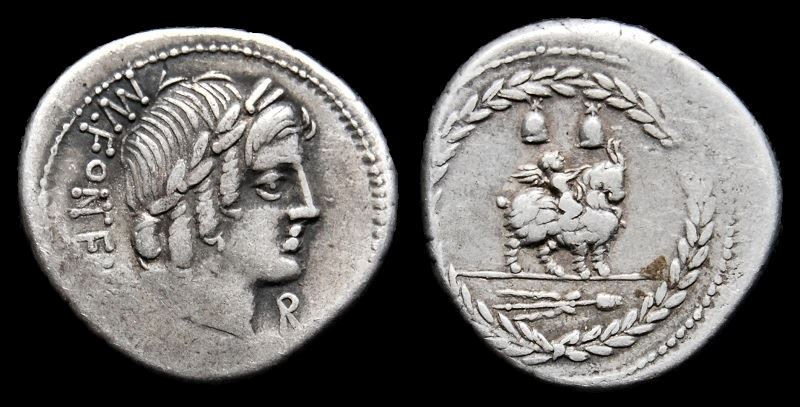
Reverse: Infant winged Genius (or Cupid) seated on goat standing right; pilei of the Dioscuri above; thyrsus with fillet in exergue; all within laurel wreath.
Die Orientation: 10 H
Weight: 3.93 g
"The moneyer is perhaps the brother of the moneyer M. Fonteius (see Crawford 347) and not inconceivably the tribune featured on the reverse of Crawford 429/1. The reverse recalls that the god Jupiter was suckled by the she-goat Amaltheia on Mt. Ida during his infancy, and depicts a statue that was within the Temple of Vejovis in Rome.
Romans believed that Vejovis was one of the first gods to be born. He was a god of healing, and was later associated with the Greek Asclepius. He was mostly worshipped in Rome and Bovillae in Latium. On the Capitoline Hill and on the Tiber Island, temples were erected in his honour. In spring, goats were sacrificed to avert plagues.
Vejovis is portrayed as a young man, holding a bunch of arrows, pilum, (or lightning bolts) in his hand, and is accompanied by a goat. He may be based on the Etruscan god of vendetta, known to them by the name Vetis written on the Piacenza Liver, a bronze model used in haruspical divination.
The studies about Vejovis are very poor and unclear. They show a constant updating of his condition and his use by people: escaping from netherworld, Volcanic God responsible for marshland and earthquakes, and later guardian angel in charge of slaves and fighters refusing to lose. God of deceivers, he was called to protect right causes and to give pain and deception to enemies. His temple has been described as a haven safe from police for wrongly persecuted people, and dedicated to the protection of the new comers in Rome, but this view is probably wrong.
The legend shows him more like an entity escaping from hell and trying to join the light and heaven, awesome fighter and protector of any people victims of unfairness. Aulus Gellius, in the Noctes Atticae, speculated that Vejovis was the inverse or ill-omened counterpart of Jupiter; compare Summanus. Aulus Gellius observes that the particle ve- that prefixes the name of the god also appears in Latin words such as vesanus, "insane," and thus interprets the name Vejovis as the anti-Jove. Aulus Gellius also informs us that Vejovis received the sacrifice of a female goat, sacrificed ritu humano; this obscure phrase could either mean "after the manner of a human sacrifice" or "in the manner of a burial." "
.jpg)
Reverse: Infant Genius (or Cupid) seated on goat right; pilei of the Dioscuri above; below, thrysus right; all within wreath
Die Orientation: 3 H
Weight: 4.07 g
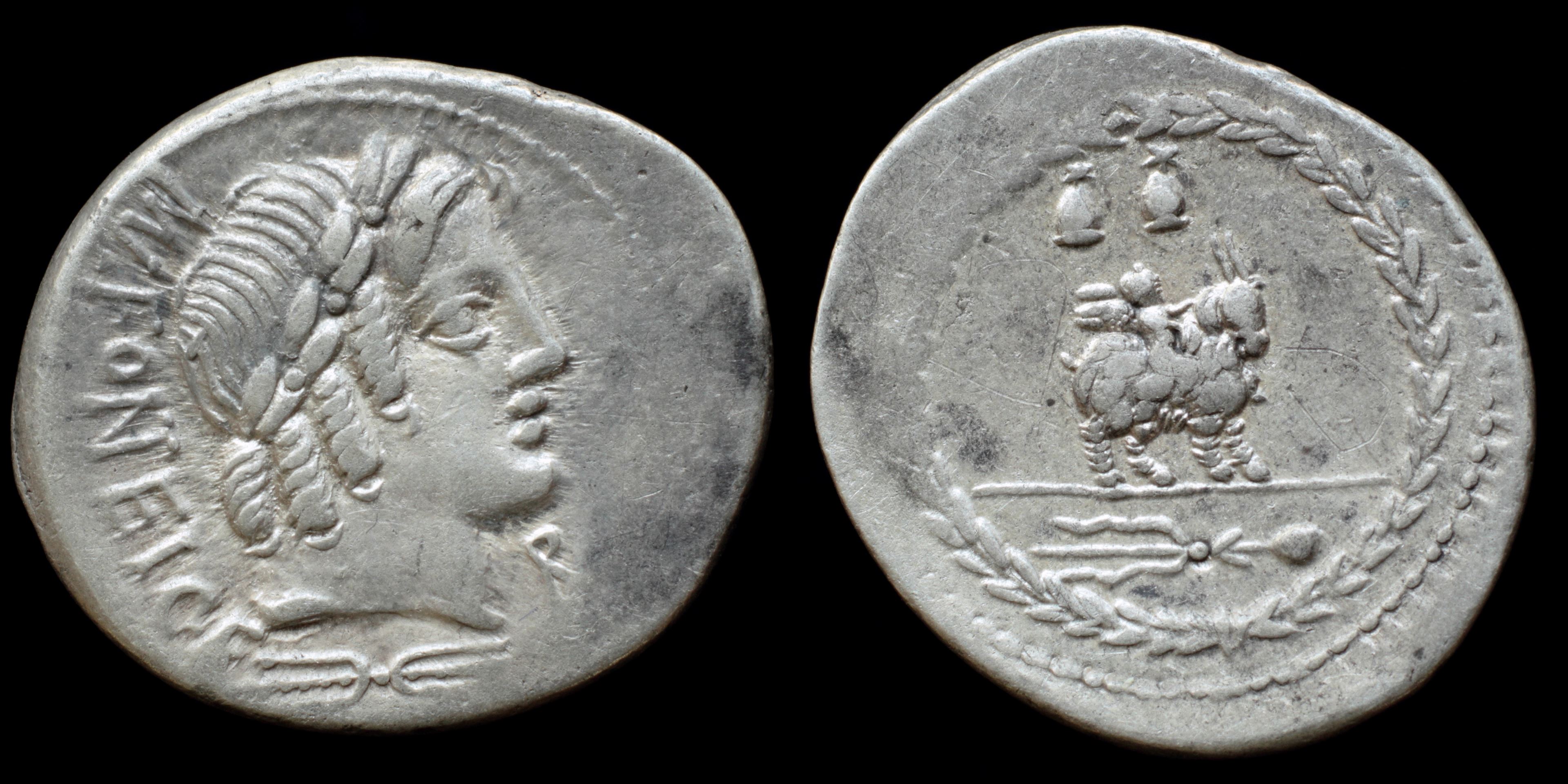
Reverse: Cupid seated on goat right, caps of the Dioscuri above, thyrsus of Bacchus in exergue, all within laurel wreath
Die Orientation: -
Weight: 4 g
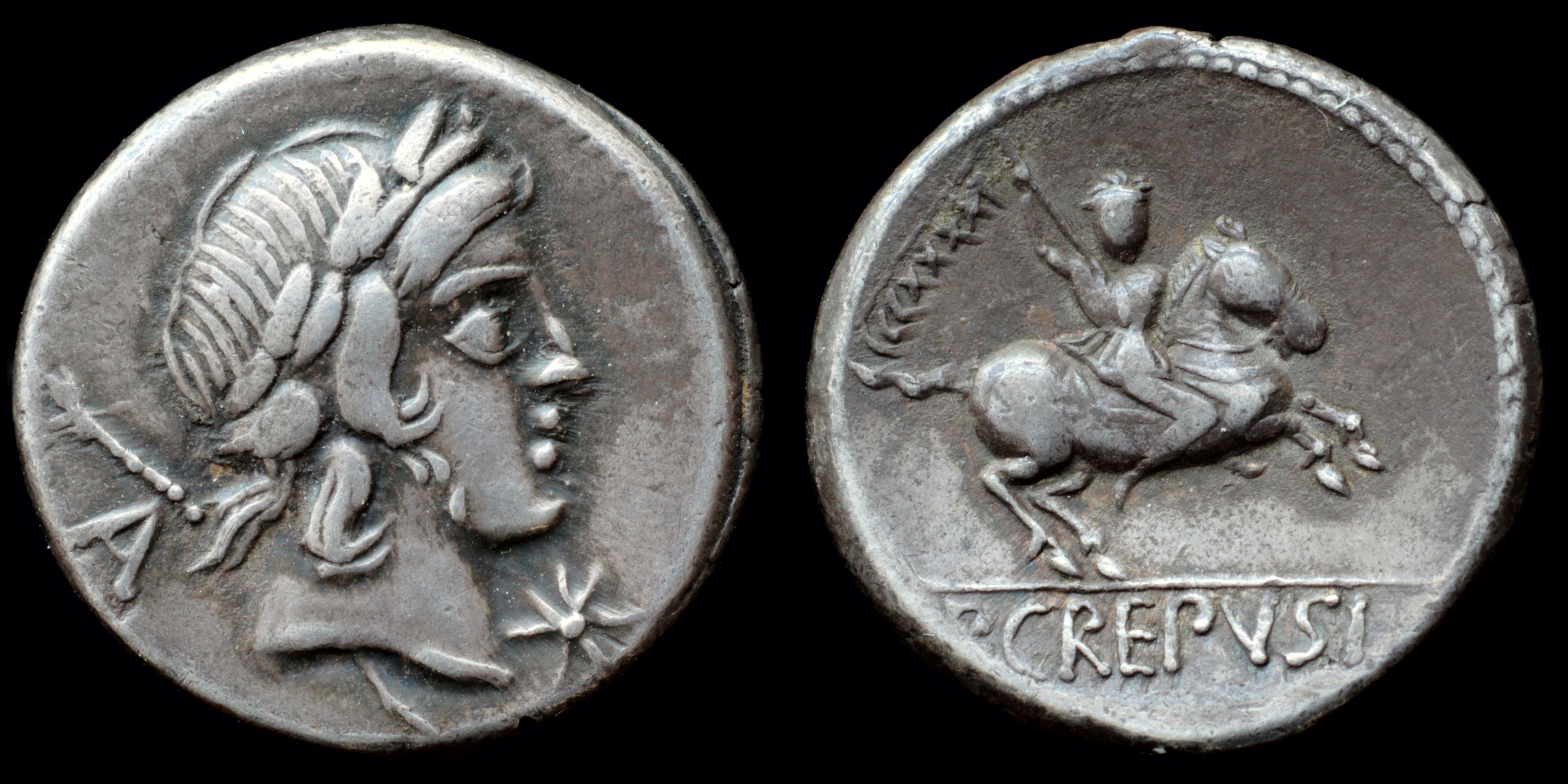
Reverse: horseman galloping right, hurling spear; CCCXXXXI / P·CREPVSI
Die Orientation: -
Weight: 4.2 g
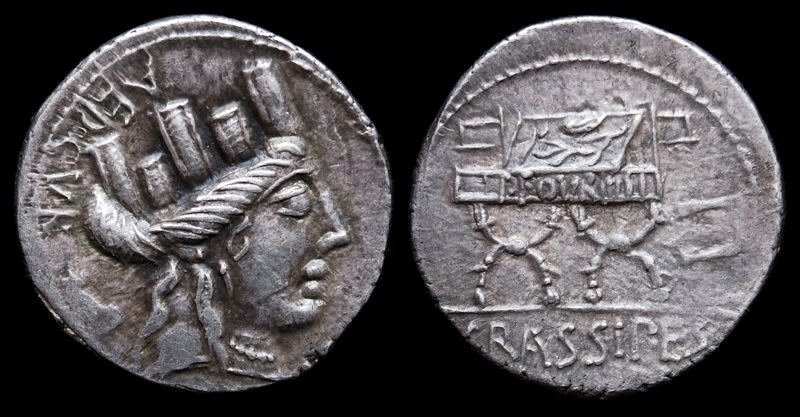
Reverse: Curule chair inscribed P•FOVRIVS; CRASSIPES in exergue.
Die Orientation: -
Weight: 3.93 g
The types of this coin and Crawford 409/2 probably refer to the Ludi Megalenses, games which honored the goddess Cybele, and were presented by the curule aediles.
Provenance: Naville Numismatics, Auction 37 (28 January 2018), lot 482.

Reverse: inscribed curule chair; P·FOVRIVS CRASSIPES
Die Orientation: -
Weight: 3.8 g
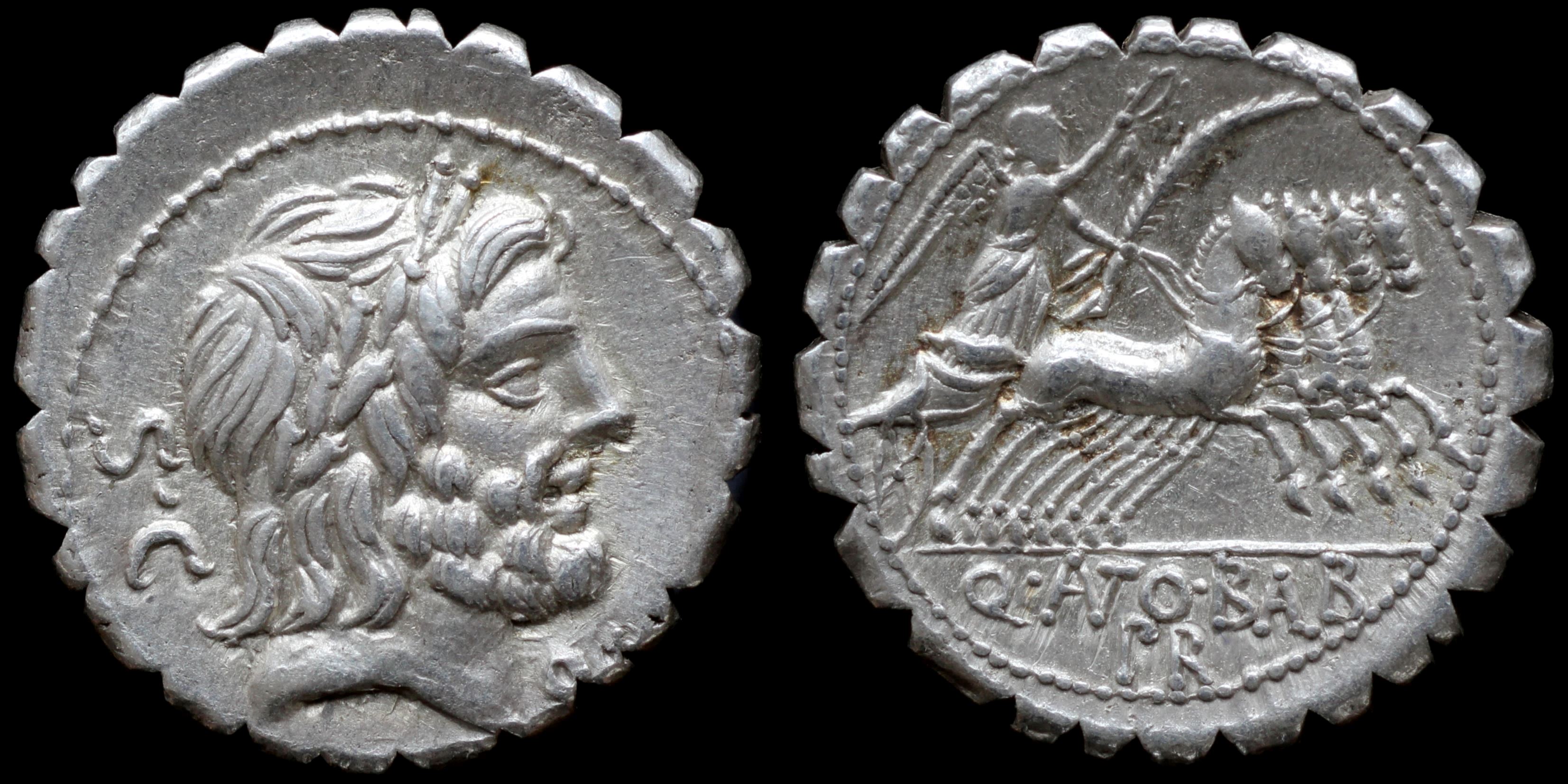
Reverse: Victory riding in quadriga right, holding wreath, reins and palm branch, Q·(ANT)O·B(AL)B / PR
Die Orientation: -
Weight: 3.9 g
Moneyer who belonged to the opposition of Sulla struck these coins as praetor in Sardinia according special decree of senate (Senatus Consulto). He was driven from Sardinia by L. Philippus, the legate of Sulla, and slain. Victory on reverse didn't avert defeat of oppositon in battle of Colline Gate.
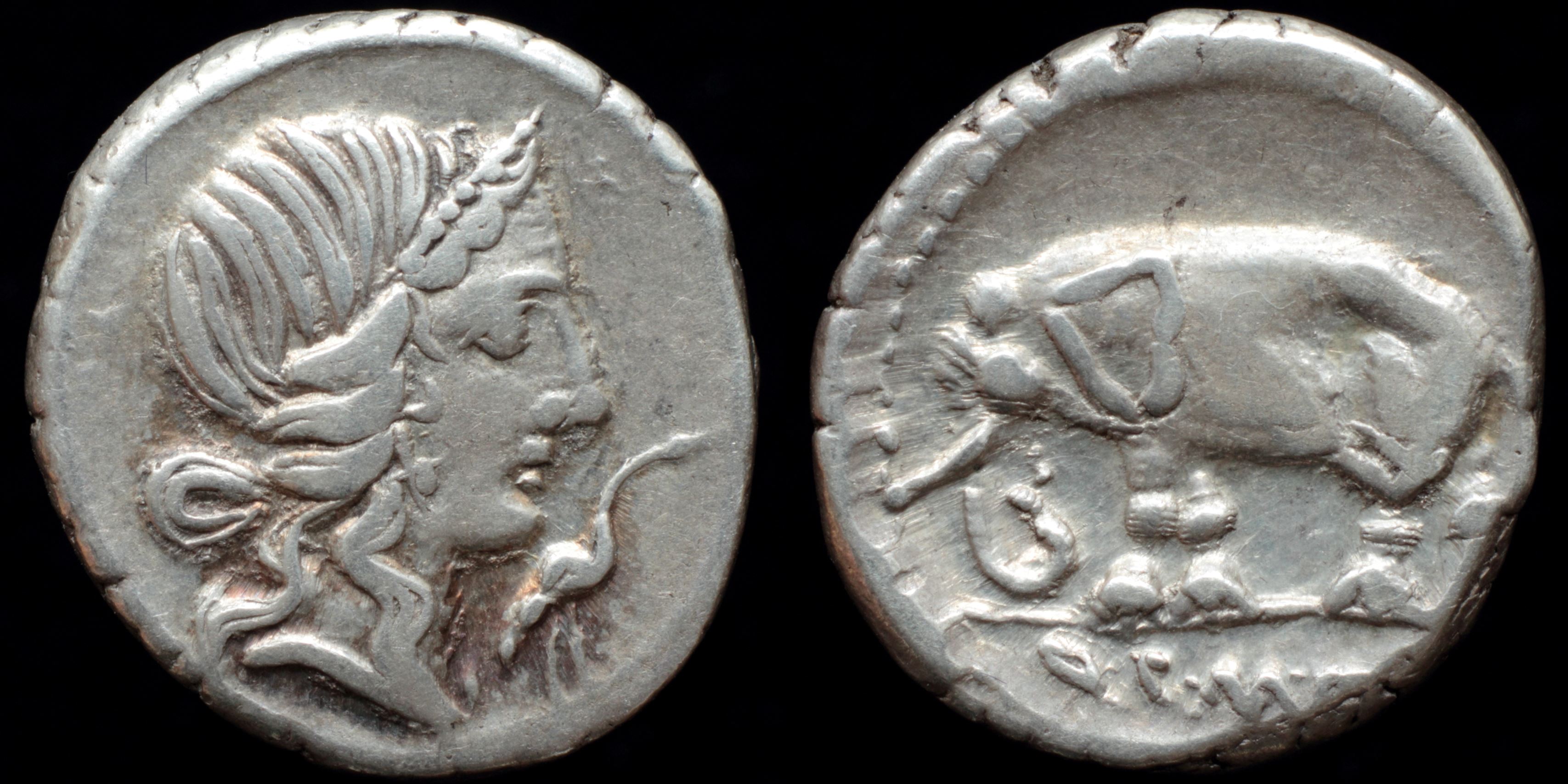
Reverse: elephant left, bell hanging from its neck Q·C·M·P·I
Die Orientation: -
Weight: 3.9 g
mint in north Italy. Elephant commemorates victory of moneyer's ancestor L. Caecilius Metellus over Hastrubal in the first Punic war 251 BC near Palermo. Seized elephants appeared in his triumph and became the emblem of the family. Moneyer received agnomen Pius in 99 BC for his effort to return his father from exile. Stork is the symbol of Pietas. Moneyer struck these coins as Imperator in the northern Italy where he fought along with Sulla. They held consularship together in 80 BC.

Reverse: Elephant walking left; Q•C•M•P•I in exergue.
Die Orientation: 6 H
Weight: 3.66 g
Metellus Pius came from one of the most important and wealthiest families of Rome. Beginning in the 3rd century BC, his family held numerous consulships, tribunates, censorships and military commands. His father, Q. Caecilius Metellus Numidicus, was the chief commander in the Jugurthine War in Numidia until Marius displaced him, and was later censor until driven into exile by Marius.
Though Metellus Pius fame is largely derived from his later campaigns in Hispania against Sertorius, the coinage in his name was struck at a North italian mint in 81 B.C, while he fought for Sulla against leaders of the Marian Party, such as Carrinas, Norbanus and Carbo. The obverse of this coin portrays the goddess Pietas and alludes to the moneyer's cognomen, Pius. The moneyer acquired the honorable title from the people of Rome, whom he had beseeched in order to secure the restoration from exile of his father. The reverse with the elephant recalls the accomplishment of his ancestor Lucius Caecilius Metellus, who in 251 B.C captured an army of Carthaginian elephants at Panormus."
Provenance: e-Bay sale, December 2017.
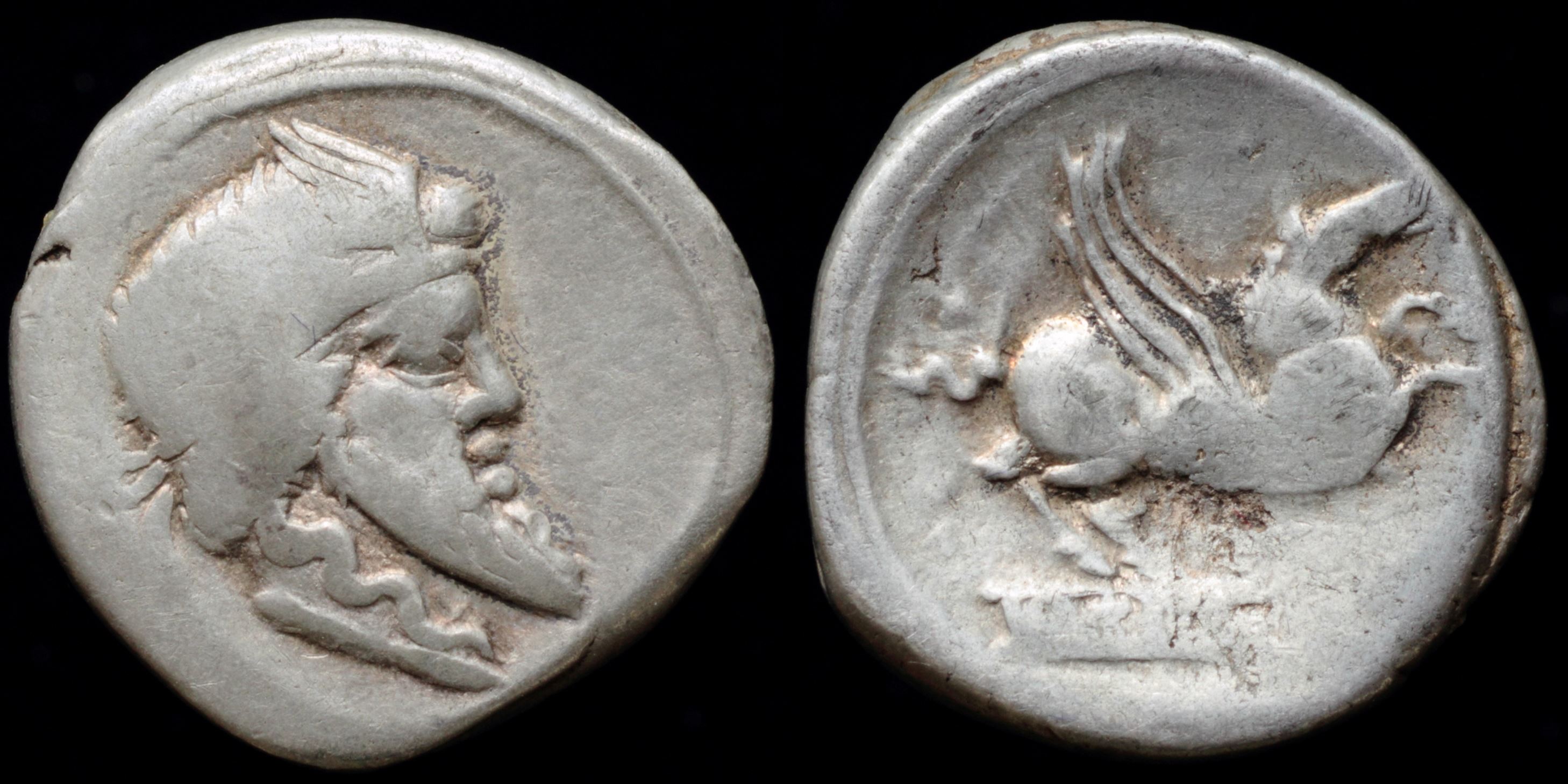
Reverse: Pegasus jumping right Q·TITI
Die Orientation: -
Weight: 3.82 g
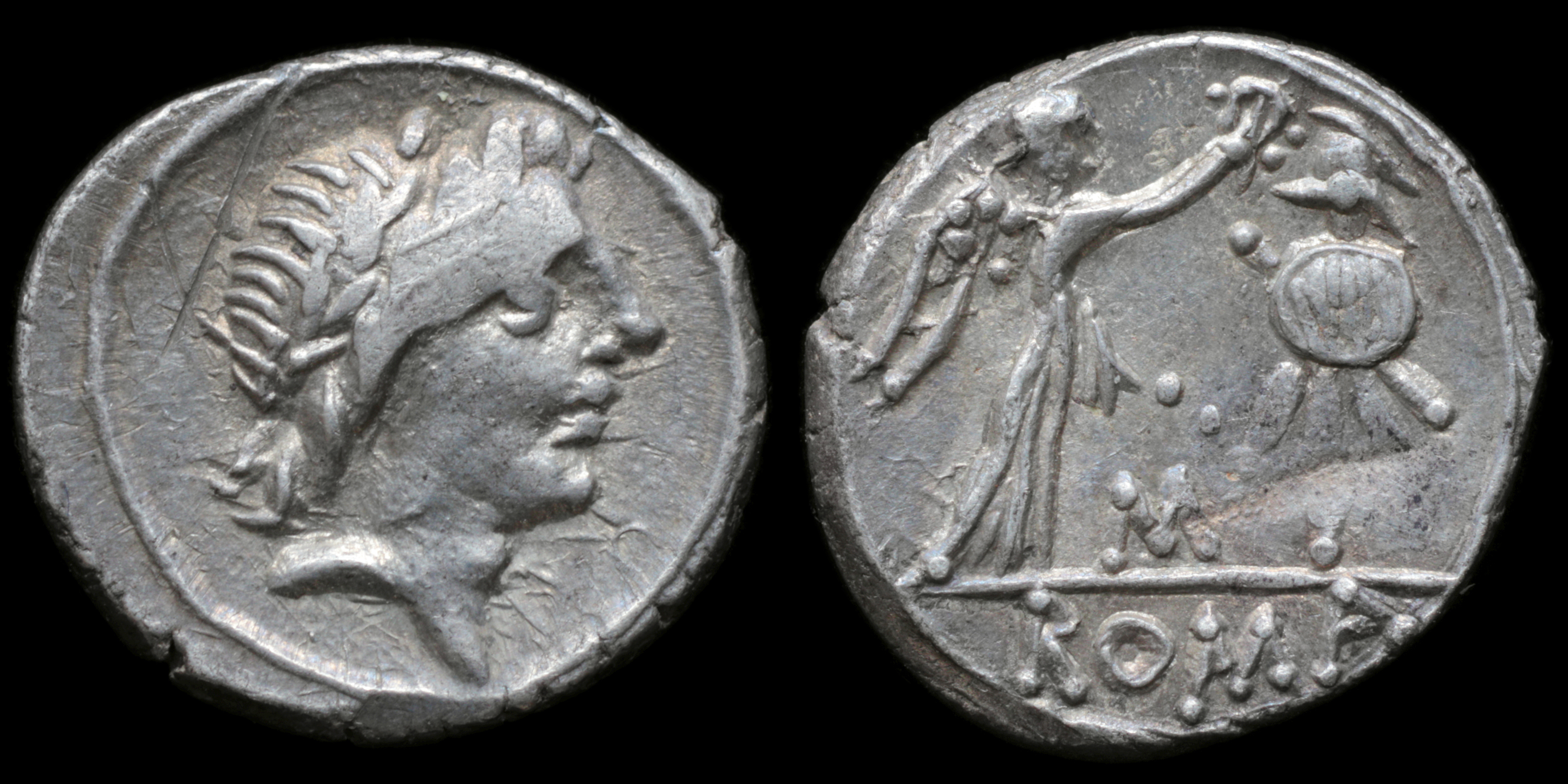
Reverse: Victory standing right crowning trophy with wreath; M / ROMA
Die Orientation: -
Weight: 1.9 g
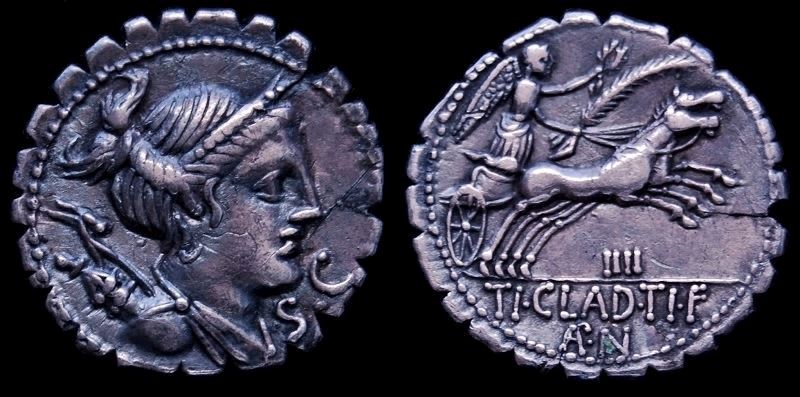
Reverse: Victory in biga riding right, holding palm-branch, reins and wreath, IIII (control mark) below. TI•CLAVD•TI•F AP•N in exergue.
Die Orientation: 10 H
Weight: 3.9 g
Provenance: e-Bay sale (June 2017).
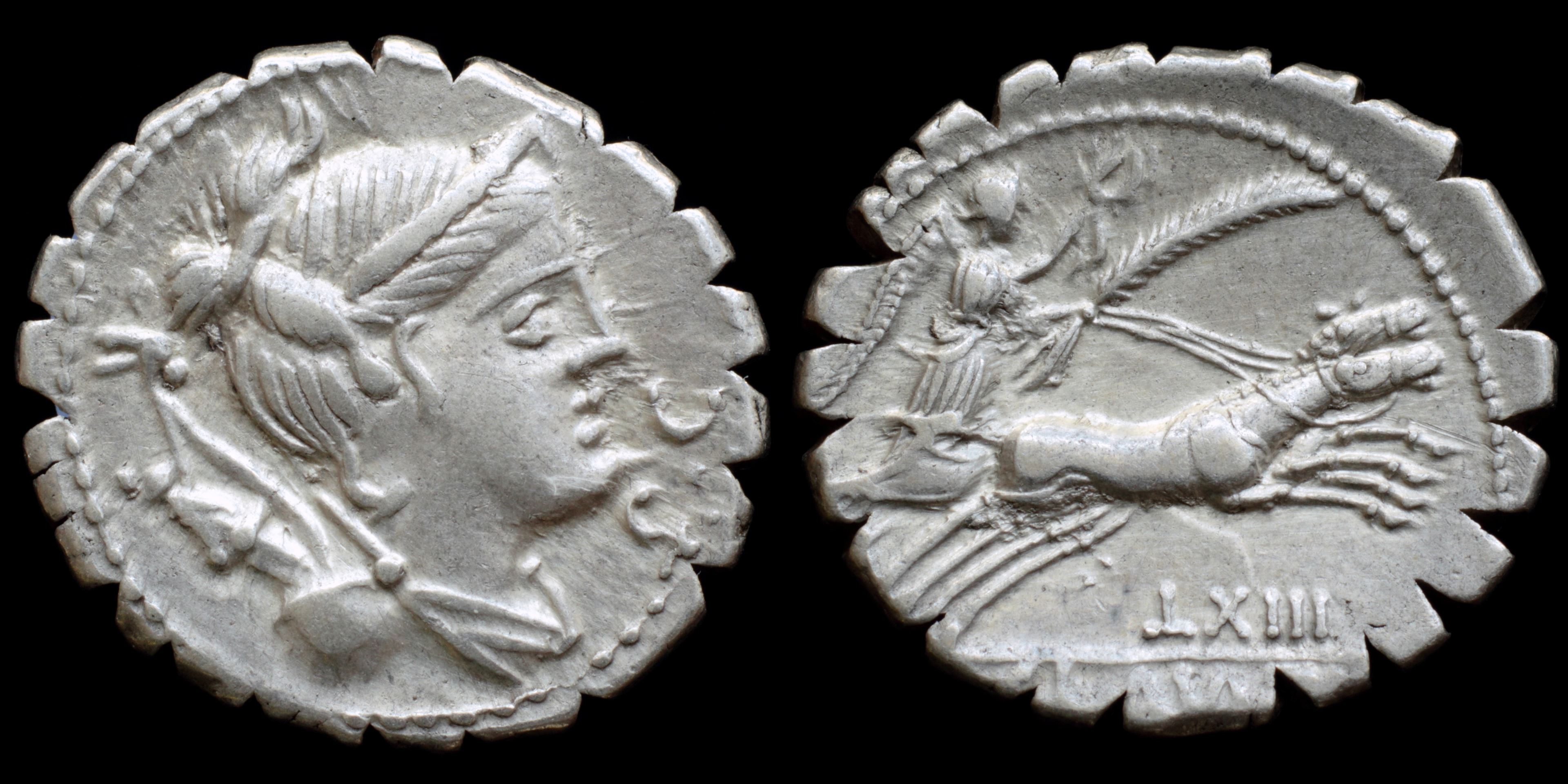
Reverse: Victory in biga right, holding wreath, reins and palm branch, LXIII TI·CLA(VD)·TI·F / (AP)·N
Die Orientation: -
Weight: 3.8 g
